
Asia > Thailand > Bangkok > Bangkok Chinatown Walking Tour
Top 10 Bangkok Tips | Suggested Itineraries For Bangkok
- Old Town Walk
- Chinatown Walk
- Chinese New Year In Bangkok
- Helpful Visitor Tips
- Suggested Itineraries For Bangkok


Bangkok Chinatown Walking Tour:
Location : Chinatown ( Yaowarat ) Cost : Free, Self-Guided ( Optional Fees Listed Below ) Style : Do-It-Yourself Walking Tour ( Self Guided ) Start : Hua Lamphong Subway Station Stop : Flower Market Ferry Stop Walking Distance : 1.8 miles for stops 1-16 (+ 0.8 for full tour ). Time Required : 1 Hour of Walking ( 5.5 Hours with stops ). Shorter Route : If you have a limited amount of time in Chinatown only do stops 1-16 which gives you the main Chinatown sights, but cuts out 3/4 of a mile from your walk. Close to where you can catch the river ferry at the Ratchawong Dock to your next destination. Best Festival : Chinese New Year In Bangkok Fun Scale : 9 out of 10
Historical Overview of Old Town:
Serving as the center of Bangkok’s gold trade for centuries, Bangkok’s Chinatown has a history older than the city itself. From the years 800-1200AD many groups of Chinese settlers found new homes in current-day Thailand. While the Siam empire grew in the North many small immigrant groups grew independently including the Chinese in what we now know as Bangkok. Siam moved its capital to the Westside of Bangkok’s Chao Phraya River near an ancient Hindu temple ( Wat Arun ) in 1767 after their Northern capital was destroyed. This new capital was known as Thonburi and sat just across the river from Bangkok’s early Chinese settlements. King Taskim welcomed even more Chinese immigrants as laborers and increased trade.
Just 15 years after establishing Thonburi, King Taksin was killed leading to a new dynasty under King Chao Phraya Chakri ( Rama I ). King Rama I decided to immediately build a new capital on the Eastside of the river, right in the heart of the growing Chinese village. In order to build his new capital called Rattanakosin ( known as Old Town today ), Rama convinced the Chinese to move a couple of miles South to Yaowarat ( now known as Chinatown ). Over the centuries to follow lively markets, Taoist temples, Buddhist shrines, and thriving restaurants have helped to create a Chinatown that rivals San Francisco and New York. Chinatown’s most significant steps forward were when King Rama V helped fix up the neighborhood’s infrastructure and roads starting in 1891. The culture is strong, especially around Chinese New Year, making Bangkok’s Chinatown a memorable place to visit.
Chinatown Walking Tour Sights:
1. temple of the golden buddha ( wat traimit ):.
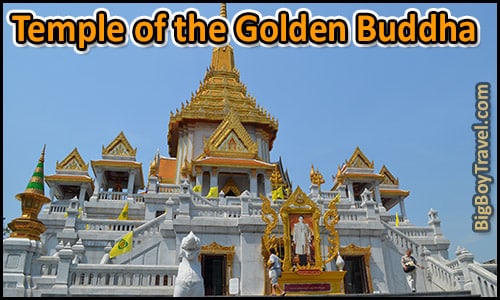
About Wat Traimit : For hundreds of years Wat Traimit was a tiny temple on the edge of Chinatown until an incredible discovery turned into one of the most visited in Bangkok. In 1955 workers were moving a giant Buddha statue when it fell and cracked, reviling a huge golden Buddha image under its plaster. The enormous golden statue, which weighs 11,000 pounds and stands over 10 feet tall ( almost 16 with its base) turned out to be the largest gold Buddha statue in the entire World .
The impressive Golden Buddha is believed to be from the Sukhothai era of Thai history ( 1200-1400s ) based on its style, but an exact date is unknown. There is a legend of a divine gold Buddha statue forged in the ancient capital of Sukhothai before being moved to the Medieval capital of Ayuthaya in the 1400s. To protect the valuable metal from Burmese invaders, the Golden Buddha was hidden under a thick coat of plaster and placed among hundreds of other statues in Ayuthaya. After the Medieval capital of Ayutthaya fell in the 1700s, the Golden Buddha was by chance among some large statues relocated to Bangkok, still under its plaster disguise .
While we are skeptical about the statue’s history and whether it is indeed solid gold old to the core, visiting the Golden Buddha today is still quite impressive. The statue has been so beloved in Thailand that in 2010 they opened open a grand new Mondop building at Wat Traimit to show it off. The multi-tiered white Mondop ( pavilion ) with gold trim, cost over $600 million to complete and it towers above the temple grounds. If you are short on time or don’t want to pay to go inside the outside is free and leads to some great photos, but we recommend going in.
After buying your ticket at the makeshift booth, head up the steps on your way to the Golden Buddha. On the way up you’ll pass the Yowarat Chinatown Heritage Center which has some good photos and exhibits explaining the history of Bangkok’s Chinatown. Once at the top of the Mondop a series of ceremonial bells lead you to the main chamber. Like any temple, you will remove your shoes and hat before entering. If you decided to sit or knell inside make sure to keep your feet tucked behind you as pointing them forward toward the Buddha image is considered disrespectful.
Wat Traimit Hours : Daily 8am-5pm; Heritage Center closes at 4:30pm. Cost : General grounds are free, a fee is required to see the Golden Buddha or visit the Heritage Center.
2. Chinatown Gate :
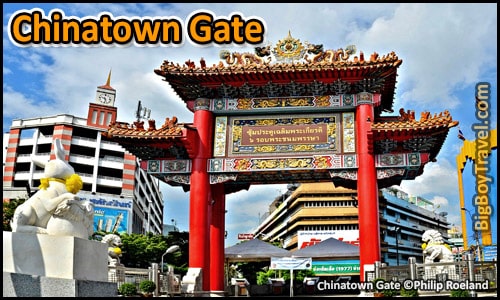
About the Chinatown Gate : Serving as the unofficial neighborhood entrance, the large Chinatown Gate sits in the middle of Odeon Circle and is a photographer’s favorite. The Gate is built by Chinese Thai citizens in 1999 to show their loyalty to King Bhumibol and was unveiled on his 72nd birthday. The sizeable Chinese writing on the Gate means “Long Live The King” and was written by the King’s Daughter Princess Maha who is fluent in Mandarin ( Chinese ).
The Chinatown Gate is an amazing place to visit during Chinese New Year In Bangkok as is serves as a hub for outdoor music and cultural demonstrations.
3. Golden Shine Foundation :
About the Golden Shine Foundation : While we’re not 100% sure what the Golden Shine Foundation does, we love taking photos of the beautiful building. The three-story Foundation is a refreshing blend of Chinese and Thai styles complete with a ton of cool dragon pillars.
The interior of the Golden Shine Foundation is an explosion of incense, bright colors, and a row of Buddhist slot machines . Slot machines you say? The machines are actually fortune telling machines representing each day of the week. If you go to the one corresponding to the day of the week you were born, put in your money, and it’ll give you your fortune as a merit. We find the experience to be really fun even if it is corny. Make sure not to miss the happy Buddha statue as it is one of the only ones in Chinatown showing Buddha in his fat and jolly image.
4. Kuan Yim Shrine :
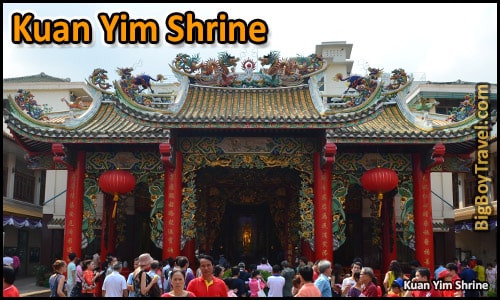
About the Kuan Yim Shrine : When you imagine a traditional Chinese temple you probably think of the ornate details, colorful accents and elegant rooflines you find at the Kuan Yim Shrine. The Shrine complex was built in 1983 by the neighboring Tien Fa Charity Foundation Hospital which has been providing traditional and modern Chinese Medicine since 1902. This is fitting as the Shrine is dedicated to Kuan Im ( Guan Yin ) who is viewed in Chinese Buddhism as the Goddess of Mercy and Compassion . Visitors come from far and wide to ask Kuan Im for good health for both themselves and their loved ones.
A visit to the Shrine begins by entering its beautiful gate and walking into a large courtyard housing the multi-colored main temple. The courtyard is often packed with visitors even though it seems oversized for the complex. Inside the flamboyant shrine, you’ll love the statue of Kuan Im which was carved out of solid teak wood in the 1200s during China’s Song Dynasty. The statue was given to the foundation in 1958 and was destined to be the focal point of a shrine.
To ask for good health leave a donation and light either some incense or a candle. If you explore further the complex also has a meditation center and a vegetarian hall which is interesting as images of Kuan Yim are also featured on many vegetarian menus around Chinatown.
Visiting Hours : Daily 7am-7pm.
5. Yaowarat Road :
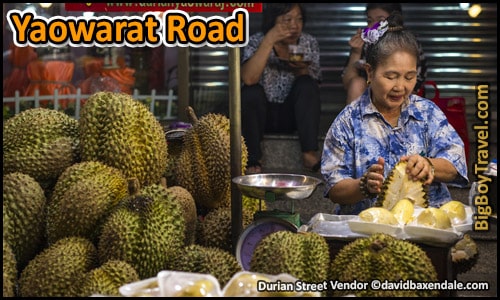
About Yaowarat Road : Yaowarat Road is Chinatown’s main street bustling with gold shops, restaurants, herbal pharmacies, and an after dark a sea of neon lights. It’s crazy to think that for the first 100 years after the Chinese were forced to relocate to Chinatown in 1782 , Yaowarat Road wasn’t much more than a dirt trading route. To improve relations with local residents, King Rama V helped to rebuild much of the neighborhood’s infrastructure and roads in 1891 making way for today’s Chinatown.
Today Yaowarat may seem chaotic, but it serves as the central artery to a network of vein-like side alleys serving as street markets. As you stroll down the Yaowarat Road you get a good feel for the pulse, energy and of course the smells of Chinatown. Many people head to Yaowarat Road just for the Scala Restaurants, and the best ones are near Soi Texas which we’ll touch on later on the free Chinatown walking tour.
6. Shanghai Mansion Hotel :
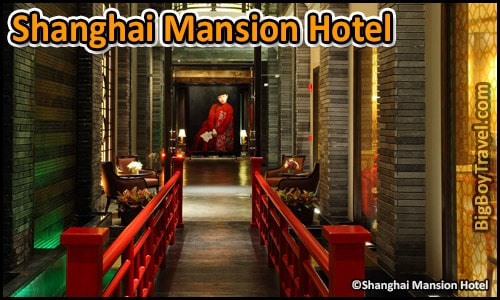
About the Shanghai Mansion Hotel : The Shanghai Mansion Hotel is our favorite hotel in Bangkok’s Chinatown. This chic hotel is within easy walking distance to any of the sights on our free Chinatown walking tour, but is still very affordable. The best part about staying here is how the cute boutique rooms are themed to feel like old Shanghai . During our last stay at the Shanghai Mansion Hotel, we were greeted with hot towels and traditional warm tea making us feel very welcome. If you are staying here and are confused on how to find the lobby, it is on the second floor up the escalator.
Hotel Website : ( HERE ).
7. So Seng Heng Goldsmith :
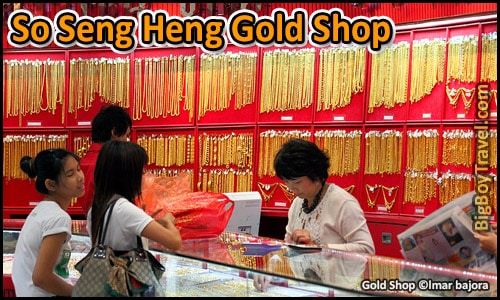
About the So Seng Heng Goldsmith : There are so many goldsmiths and gold shops in Bangkok’s Chinatown that it’s hard to keep track, but the So Seng Heng Goldsmith is the favorite one among locals . So Seng Heng is also the largest gold shop in town sitting predominately on the corner taking up a considerable chunk of the block. It can be easy to get confused about which building the So Seng Heng Goldsmith is since the signs aren’t in English. To find it, just look for the largest of all the vertical business signs topped with a massive dragon.
If you don’t feel like crossing the street to check it out there are also plenty of smaller gold shops you can pop into as well. Be careful buying gold from small back street shops as there are many hole-in-the-wall operations in Bangkok that aren’t very trustworthy compared to the big well-known gold shops.
8. Soi Texas :
About the Soi Texas : The alleyway known locally as Soi Texas runs along the Thanon Phadungdag Road and is packed full of oddities. At its entrance, you’ll run into stands cooking all sorts of things from Stinky Fruit ( Durian ), to baby squid and more. Further down Soi Texas there are funny stands of bootlegged porn movies and probably the main draw, the Scala Restaurants. Of these restaurants, you’ll actually find the world’s best crab fried rice at Rut and Lek Seafood , right on the corner of Yaowarat and Soi Texas.
You may notice that a few of the restaurants in Chinatown have a bunch of bird and shark symbols which indicates they sell both Bird’s Nest and Shark Fin Soup . Both sound a little gross but are delicacies in Asia. The harvesting of the nests for the Bird’s Nest Soup is highly accepted as they are gathered from caves, but the Shark Fin Soup is extremely unethical . In many countries, the harvesting of fins for Shark Fin Soup is illegal as the fishermen catch the sharks, cut off their fins, and toss them back into the water still alive to die a slow death. Most of the fin harvesters don’t even use any of the rest of the shark and it seems overly inhuman. Much like the shady practice of poaching Rhinos to grind up their horns, many groups in Asia wrongfully believe there are medicinal properties to eating exotic animals. In reality, it won’t make you feel like more of a man, won’t make you live longer or give you a stronger boner so you can safely pass on trying Shark Fin Soup.
Soi Texas Location : Runs along Thanon Phadungdag Road.
9. Yoo Chinatown Fishballs :
About Yoo Chinatown Fishballs : If you want to eat traditionally but have felt uncomfortable with the street food you’ve seen along Yaowarat Road, then Yoo Chinatown Fishball is the place for you. Because it is typically a safe place on the stomach to eat at, Yoo Chinatown Fishball is the perfect place to get your toes wet. The food is cheap too at just 40 Baht for a bowl of soup and the Yoo Family has been making fishballs since the early 1900s. The restaurant is so popular that even Thai Princesses have been spotted at this historic venue. Did we mention it has air conditioning?
Hours : Daily 10am-9pm. Location : 433 Yaowarat Road.
10. New Market ( Talat Mai ):
About the New Market : Open air produce market and food stalls, usually with tons of hanging lanterns that are lit up at night. If you follow the market down 1 block to Istsara Nuphap Street you’ll also a bunch of stands selling knock-off purses. As you round the corner of New Market keep an eye out for the Kun Do Shrine which has a large smiling and golden horse head that is supposed to bring you good luck if you donate produce to it.
Location : Runs along Yaowarat side road #11 and rounds the corner onto Istsara Nuphap Street. Hours : Daily Dawn-Dusk.
11. Old Market ( Talat Kao ):
About the Old Market : If you are a photographer you will love walking through Talat Kao Old Market. This alley-like covered market has been around since the late 1700s and has a range of spices and fresh seafood to get your senses going. Everything seems interesting from guys hacking away at huge blocks of ice to cooks frying up creatures you’ve never seen before. They say the best action of the entire day happens in the morning, but we’ve had tons of fun regardless of what time it is.
Location : Runs along the covered alley Yaowarat #6. Hours : Daily Dawn-Dusk.
12. Leng Buai Ia Shrine :
About Leng Buai Ia Shrine : Built in 1658, the Leng Buai la Shrine is not just the oldest Chinese Temple in Bangkok , but perhaps all of Thailand. It is so old that it was built while Ayutthaya was still the capital of Siam, long before Thonburi or Bangkok. Inside there is a shrine dedicated to Leng Buai Ia and his wife in the center, a shrine dedicated to the deity Going-Wu on the left and a shrine dedicated to the Queen of Heaven on the right. We love taking photos at this temple including the one on the cover photo on the top of this page as it is largely free of tourists.
Hours : Daily 7am-5pm.
13. Dragon Flower Temple ( Wat Mangkon Kamalawat ):
About The Dragon Flower Temple : This Temple is probably our favorite one in Chinatown as the maze of a shrine has a magical feel. It was built in 1871 with the Chinese name Lenf Noei Yi Shrine before later having King Rama V change its name to the Dragon Flower Temple. Unlike many temples that have a shrine for a specific purpose, the Dragon Flower Temple has a bunch of different shrines. It is said that if you pay homage to all of them you will have good luck in life, health, business, and family life.
As you go through the elaborate entrance a large courtyard and cloud of incense quickly let you know this place is special. Make sure to by some joss paper Bank Notes as you enter the Temple to burn as an offering. In Buddhism, these fake bank notes are burned in order to have them in the afterlife. There are also many tables to buy incense and candles as which can be a truly moving experience. The burning and scent are not only used as offerings but are also meant to remind you to try to burn away your own negative qualities.
The Ordination Hall ( Ubosot ) has a many large gold Buddha Statues and alter is used for rite of passage ceremonies. Many of these ceremonies involve the nearly 300 young monks that go to school within the Dragon Flower Temple itself. The 3 largest Buddha statue represent from left to right Pure Land ( Amitabha ), Being Humane ( Sakyamuni ), and Medicine. Sermon Hall ( Wiharn ) stands 4 huge colorful statues of the Guardians of the World ( Thao Chatulokaban ) dressed in Chinese warrior outfits.
Other statues in the Temple included rows of Saints from local Chinese belief and at least 40 other Buddha images. The last time we went to the Dragon Flower Temple the statues of the Saints all have pink feminine dresses on with no explanation of why. In the rear of the Temple are 3 smaller shrines with one for the Goddess of Compassion Guan Yin, another for the Temple’s Founder, and the last one for the Saint Lak Chow.
Hours : Daily 6am-5pm.
14. Temple for Kan’s Mother ( Wat Kanma Tuyaram ):
About the Temple for Kan’s Mother : The temple Wat Kanma Tuyaram has an amazing has white gate with lots of carved details. It is kind of a shame that there is a birds nest of power lines hanging right from the gate, but we still find it impressive. The Temple itself was built in 1864 by a guy named Kan Darunraksa for his mother and the name literally translates into Temple for Phra’s Mother. The rest of the Temple isn’t that cool but make sure to check out the gate.
15. Tang To Kang Gold Shop :
About Tang To Kang Gold Shop : Built in the 1880’s, this seven-story building is the Oldest Gold Shop in all of Bangkok! The gold trade has been very important to Chinatown over the years making Tang To Kang a cornerstone of the community. They also have a gold museum that we were able to walk right into but most times you need an appointment. Right across the street from the Gold Shop is the often photographed Bangkok Bank Building. The best way to know you are at the historic Tang To Kang Gold Shop is to remember it sits right at the intersection where you meet Soi Wanit, also known as Walking Street.
Hours : Monday-Saturday 9am-4pm, Closed on Sundays.
16. Walking Street ( Sampeng Lane ):
About Walking Street : Chinatown’s alley-like Walking Street is one of the oldest roads in the neighborhood and has served as the main dry good market for centuries. Walking Street may be mainly filled with shops today, but the alley was once was peppered with brothels and gambling mixed in between shops and traditional homes. The alley started to change in 1870 when it became Chinatown’s 1st paved road and again in the 1900s when it gained a covered roof. Expect your 1st visit to be annoying and feel claustrophobic at first. Expect to find more junk and knock off toys than things you actually want to buy. Then expect that halfway through your sometimes single file visit you stop hating Walking Street and will start to love it.
Why will you start to love this crowded alley? For the same reasons you hate it. Remember that some the best traveling it to visit new places, experience new cultures, and to feel like you actually left home; Walking Street does gets you there. Anyone can go visit a modern mall, but it is visiting an authentic everyday market like Walking Street where one gets into the guts of Chinatown. Chinese Shop Houses on Maha Chak Rd ( northwest of the intersection between Sampeng Lane and Maha Chak Rd ) yellow stucco.
17. Wat Chakrawat :
About Wat Chakrawat : A fairly average temple complex, but is famous for its ponds with crocodiles . We only saw 2 of them when we stopped by, but it was still kind of cool. Main entrance on the Westside, but smaller gates on the East and North are usually open. The Khemer style tower on the North side is a good landmark to help you spot the large Temple, as it can get lost in the urban jungle.
18. India Emporium Mall :
About The Mall : The Emporium is the center of the small Little India neighborhood and a great place to get a break from the heat for a few minutes. A large portion of the mall is fabric sales but they also have many tacky souvenirs. There is not only a nearby convenience store for buy a drink but a public bathroom right inside the Mall itself. Be prepared for the bathroom to not have any paper towel or toilet paper. Don’t expect to actually find many things you will actually want to buy at the mall, but it is still worth stopping by while you walk past especially if you need a break from the heat.
19. Guru Tawan Sikh Temple :
About Guru Tawan Sikh Temple : Second Largest Shikh Temple outside of India, 6 stories tall with a large gold dome. Shikhs are a very peaceful people known for their gurus. While visiting you must remove shoes and women need to cover their hair with a provided orange scarf. As the neighborhood is largely made up of people with Indian heritage, a visit to the Sikh Temple makes your visit feel more special.
Visiting Hours : Daily 10am-6pm. Admission Cost : Free. Temple Website : ( HERE ).
20. Wat Ratchaburana :
About Wat Ratchaburana : A little bit of an underwhelming Temple complex the coolest part is the Prang tower right by the road. The complex has buildings representing numerous religions. You are bound to be curious, but trust us that it doesn’t compare to the other temples in Chinatown. We recommend checking out the Temple’s beauty from the road then move on to the next stop.
Visiting Hours : Daily 6am-6pm, free admission.
21. King Rama the 1st Memorial :
About The King Rama the 1st Memorial : King Rama I took over the Kingdom of Siam in 1782 when the previous King Taksim was killed. Rama was the 1st in the Chakri Dynasty to gain power over the Kingdom and wanted to build his own new capital complex across the Chao Phraya River. The old complex had been in Thornburi on the Westside river by Wat Arun and the new one was on the Eastside where Old Town Bangkok sits today. This move officially established Bangkok as city and the Chinese settlers that were previously on the land were moved to the area we now call Chinatown. King Rama I is still considered a very well-liked King and this statue was built in his honor in 1932 for the Bangkok’s 150-year celebration.
22. Yodpiman Indoor Flower Market :
About Yodpiman Flower Market : The Yodpiman Flower Market is the newer of the two large riverside markets and is probably the one most visited by tour groups. This market is also a little bit cleaner with better lighting, but we like to stroll through both for the contrast. If you are walking around trying to find out how to get inside, the entrances are littered with flower stands making them look like crowded alleys, but they are there. If you see any alleys covered with flowers, they will surely be one of the many entrances into the market.
Visiting Hours : Daily 24/7; busiest from 3-4am. Free admission.
23. Flower Market Street ( Chakphet ):
About Flower Street : During the day, and sometimes at night, Chakphet Street outside of the flower markets gets littered with roadside flower stalls. The street stalls are basically part of the connected markets themselves, but we feel it is an important point of reference for you to help you get you barrings.
24. Pak Khlong Talat Flower Market :
About Pak Khlong Talat Flower Market : Sitting at the mouth of the canal the Pak Khlong Talat Flower Market is the grimier of the two covered markets but we find it to be really cool. Starting in 1782 there was a floating flower market at this very spot which thrived for over 100 years before being replaced with a floating fish market. The fish market did fine, but by the mid-1900s it was replaced by the current warehouse-style covered flower market.
If you want to look more behind the scenes to see how the market works you are free to walk in the riverside alleys behind the market. It is chaotic and dirty, but very interesting ( use caution ). Like the other flower markets, this one is the busiest from 3-4am when local businesses come in the get the pick of the litter from the midnight deliveries.
25. Guan Yu Shrine :
About The Guan Yu Shrine : Every time you travel up and down the Choa Phraya River there is one temple that always stands out with its Old World Chinese appeal. That temple is called the Gaun Yu Shrine and it serves as the gateway to The Princess Mother Memorial Park. No matter what time of day you pass it, the strings of lanterns draw you in and they are magical after dark.
Guan Yu was a Chinese warrior from around 100 AD who was made famous when he was featured in the famous novel Romance of The Three Kingdoms . Today, Guan Yu is portrayed as a red-faced warrior who is a protector of Buddhist Temples. Chinese Taoists also worship here as they view Guan Yu as a Saint who fights off demons.
26. Chee Chin Khor Tower :
About Chee Chin Khor Tower : This 8 story tall Chinese Pagoda opened in 2001 and was connected to an existing temple. While you can climb the tower to get good views of the Bangkok skyline, we prefer to just view the Tower from the river boat ferry instead of actually stopping here.
27. River City Shopping Center :
About River City Shopping Center : The small River City Shopping Tower is a hidden gem of Bangkok. The shopping might not be that good but it is a major stop on the ferry lines with a really cool boardwalk. The highlight of River City’s boardwalk is a cool shark statue coming right out of the dock to bite down on a bench. This is one of the best photo opportunities in Bangkok. The top level of the mall is also home to one of the best rooftop bars in Bangkok. The prices at the rooftop bar are very affordable and it has excellent river views. The dock next to River City is also the meeting point for most of Bangkok’s top evening dinner cruise .
28. Holy Rosary Catholic Church :
About Holy Rosary Catholic Church : Has been a church here since 1736, has been rebuilt twice with the current in 1897. Originally Portugal was huge in trading with Siam so King Rama I gave them this land for a church. Catholics from other Asian countries still use this church, especially war refugees. Visually the church looks like a mini version of New Orleans’ Saint Louis Cathedral and is probably cooler to know about than to actually see in person.
29. Junk Shops ( Sieng Kong ):
About The Junk Shops : Huge stacks of used automotive and engine parts line the street shops from here all the way to the Chao Mae Tubtim Shrine 3 blocks to the North. Even though the street is very crowded with junk, it is beyond interesting to see how the locals live their day to day lives. These shops are best views during the daytime as at night it is very dark and we don’t recommend it then.
Other Sights Near Chinatown:
30. old town bangkok walking tour :.
About Old Town Bangkok : Bangkok’s Old Town is the heart and soul of the city. From the Grand Palace, Temple of the Dawn, Emerald Buddha, and Wat Pho, this is the most must-see area of Bangkok.
Read More : Old Town Bangkok Walking Tour
Featured Article

Sign Up For Our Newsletter For Free Travel Tips
Email Address *
Disclaimer: Information on this page and in our walking tours were deemed accurate when published, however, details such as opening hours, rates, transportation, visa requirements, and safety can change without notice. Please check with any destinations directly before traveling.

Exploring Yaowarat – A Walking Tour of Chinatown Bangkok
- Last Updated: January 12, 2023
Everything you need to know about exploring Yaowarat, otherwise known as Chinatown Bangkok, on a sensational guided day tour with the incredible local, social enterprise HiveSters.
Bangkok is one of the world’s most fascinating cities, and you could spend a lifetime exploring every street and alleyway of its bustling, vibrant neighbourhoods.
Backpackers will flock to Banglamphu to party on Khao San Road, and shoppers and restaurant diners will hang around Sukhumvit and Ko Rattanakosin is home to the city’s most incredible attractions such as Wat Pho and the Grand Palace.
For a taste of local life and a colourful historic community though it’s worth spending some time in Yaowarat, Bangkok’s Chinatown area.
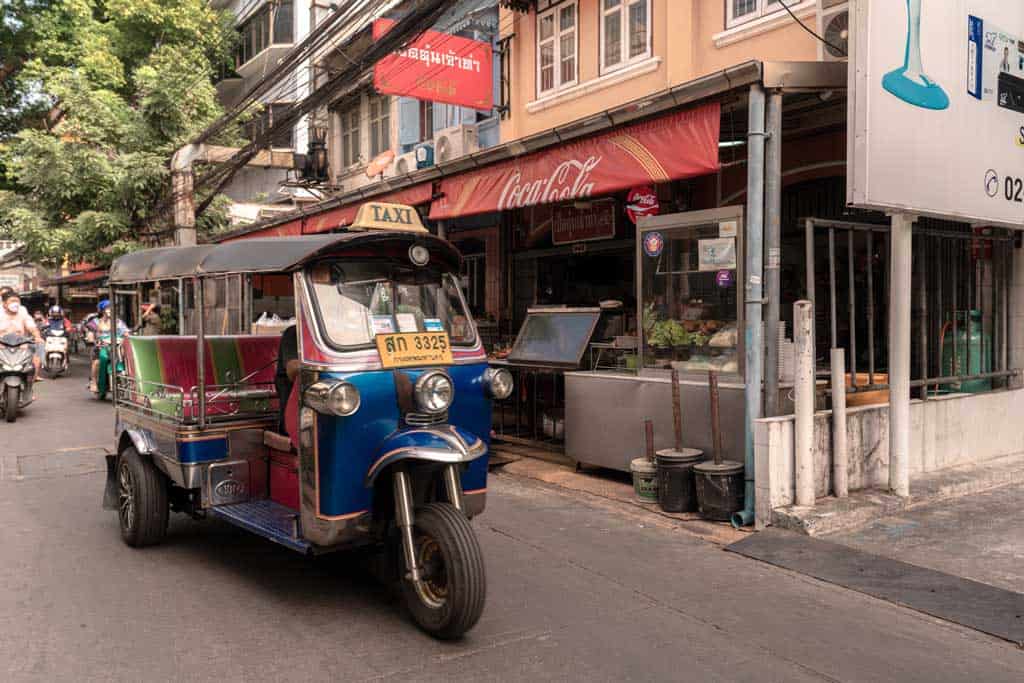
Table of Contents
Wandering Around Bangkok’s Chinatown on a Walking Tour with HiveSters
1) see the golden buddha at wat traimit, 2) check out the chinatown gate at odeon circle, 3) stop by wat mangkon kamalawat, 4) feast at chinatown’s street food markets, 5) photograph the talat noi street art, 6) stop by so heng thai mansion, 7) grab a drink on the rooftop of luk hostel, 8) stop in for a coffee at hong sieng kong, 9) chat to the locals to learn about chinese and thai cultures, 10) see all the chinese temples and alleyways, is bangkok chinatown worth visiting, a brief history of chinatown in bangkok, booking a walking tour of chinatown.
On our most recent trip to Bangkok we spent the day exploring Bangkok Chinatown with one of Thailand’s best tour companies, HiveSters.
Operating as a social enterprise with profits going back into local communities, HiveSters have been up and running since 2014, with unique tours forming a significant part of their positive impact strategy.
We joined their ‘ Hidden Chinatown ‘ tour, led by the wonderful guides Pum and Pizza, and had what proved to be one of the best days we’ve ever spent in Bangkok.
If you’re looking for a Bangkok Chinatown day tour, you won’t be disappointed with what’s on offer with HiveSters.
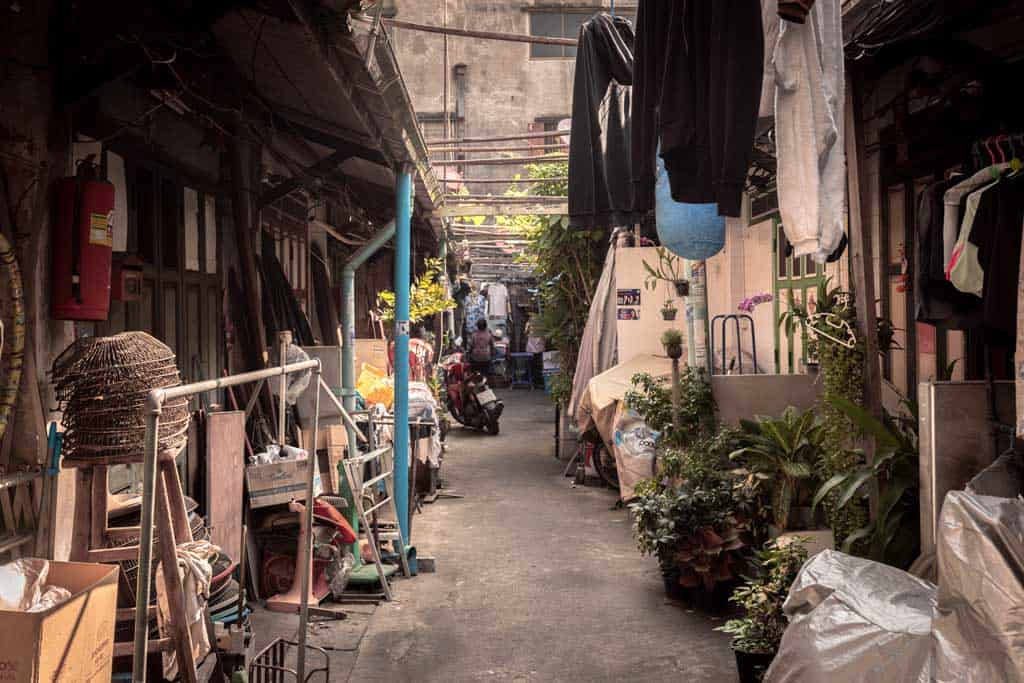
10 Things to See in Chinatown Bangkok
There are so many things to see and do in Chinatown Bangkok that you could easily spend a week wandering around and never grow bored.
If you love history, architecture, Chinese and Thai cultures, great food stalls and beautiful temples, you’re going to love this part of town.
Here’s our recommendations for the best things to do in Yaowarat.
We started our day at Wat Traimit , and even if you’re only coming through Chinatown for a few minutes you need to make this your first stop!
This temple is famous for housing the largest Golden Buddha in the world. The Golden Buddha temple is located not far from the China Gate and is free to enter.
While the exterior is a sight to behold, the real highlight is the 5.5 ton Golden Buddha statue on the inside, valued at over $250 million!
While no one knows quite what the origins are of the Golden Buddha, it is thought to have been created in the 13th century and at one point in time it was covered in plaster to disguise its value.
The stucco-covered statue was later installed in Wat Chotanaram, and when the temple closed it was being transported to a new location it was accidentally dropped, chipping away the plaster and revealing the gold interior.
Upon analysis the Buddha was discovered to actually be made of 9 tight-fitting parts. A key was soon found which allowed each section to come apart for easier transport.
In 2010 a new building was constructed at Wat Traimit to properly house the Golden Buddha.
- Location: 661 Charoen Krung Rd, Talat Noi, Samphanthawong, Bangkok
- Open: Daily from 8 am to 5 pm
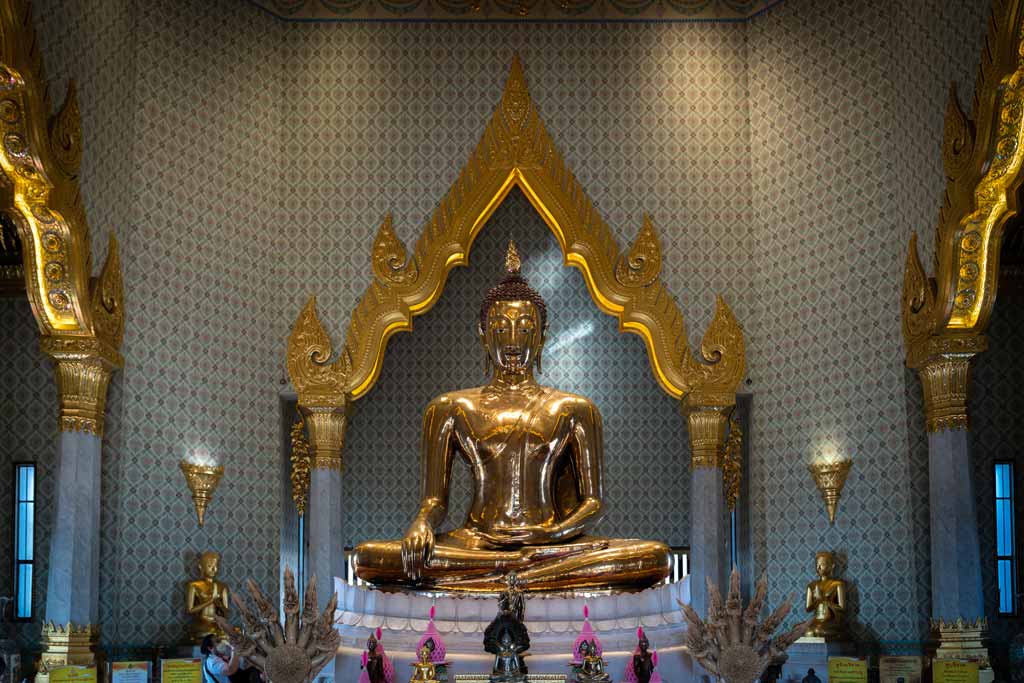
As you are walking along Yaowarat Road you will come across the enormous Odeon Circle, with the Chinatown Gate featuring in its centre marking the official entrance to Chinatown.
Odeon Circle is the beginning of the main thoroughfare of Yaowart, which gave the spot the nickname the ‘Dragon’s Head’.
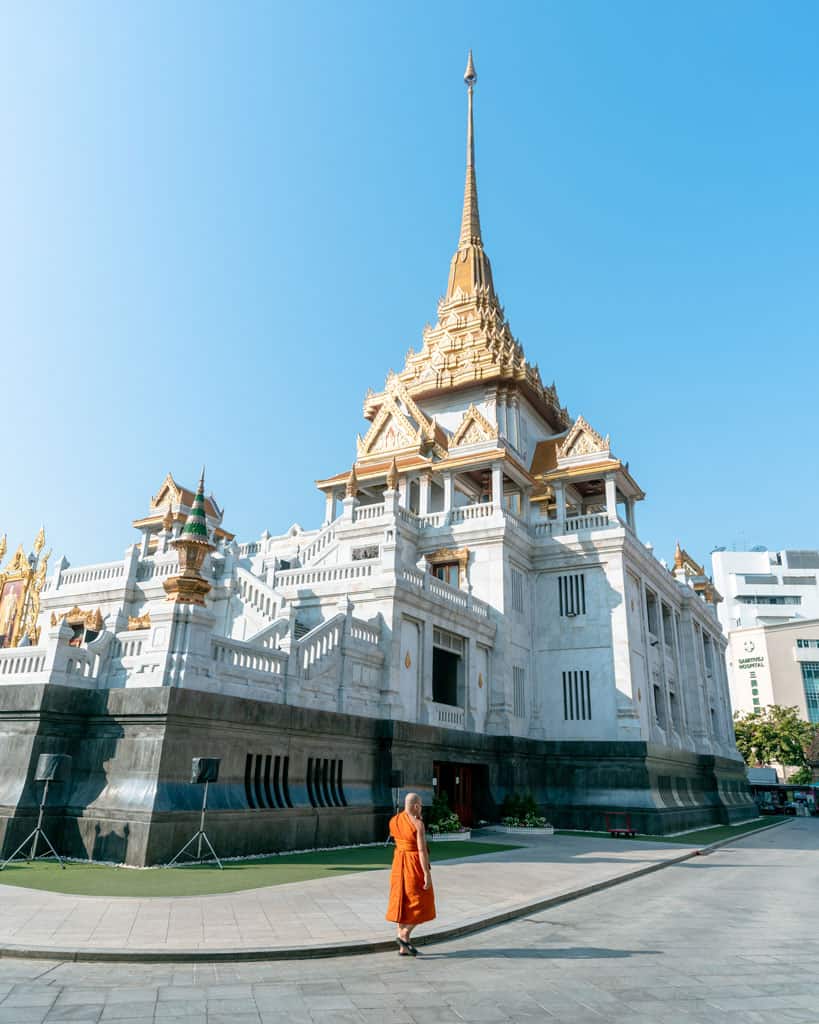
The largest Chinese-Buddhist Temple in Bangkok is Wat Mangkon Kamalawat, centrally located on Charoen Krung Road and a hive of activity around Chinese New Year.
Meaning Dragon Lotus Temple, Wat Mangkon Kamalawat is home to a number of special shines from Buddhism, Taoism and Confucian beliefs.
You can find the temple a few hundred metres to the northwest of Wat Mangkok MRT Station.
- Location: 423 Charoen Krung Road, Pom Prap, Pom Prap Sattru Phai, Bangkok
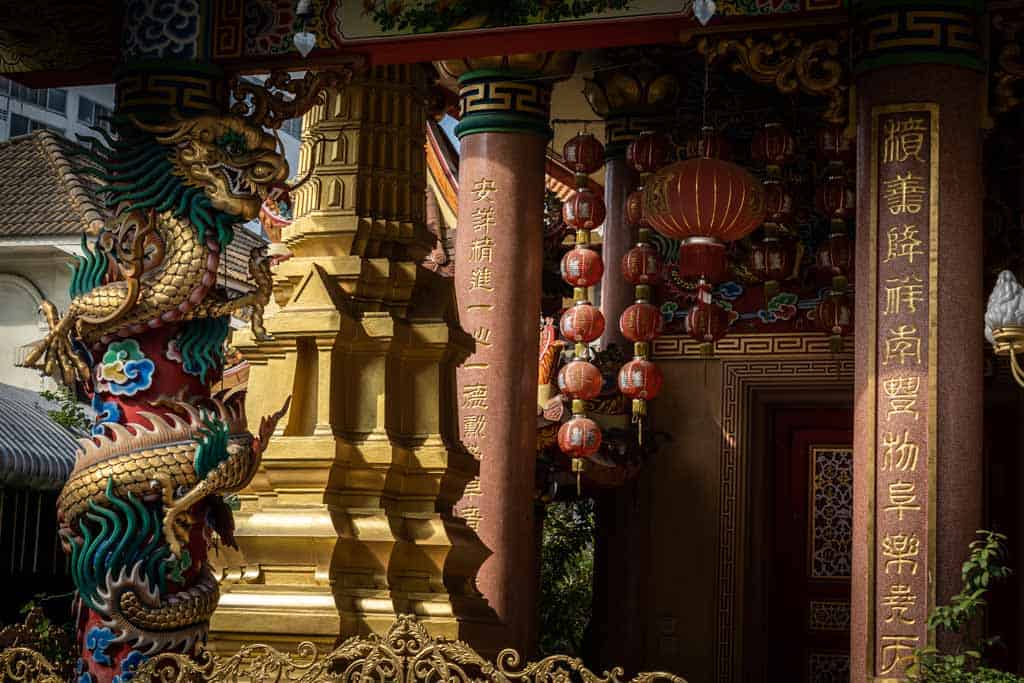
Forget the temples and Golden Buddha – If there’s one thing Chinatown is most famous for, it’s the food!
With hundreds of street food stalls, restaurants and even a wet market scattered throughout the small neighbourhood, make sure you skip breakfast on the day you come here.
You’ll find every type of food your imagination can dream of here, from exotic fruits to spicy meat skewers to boutique pastries, and the more adventurous you are the more your taste buds will thank you.
READ MORE: Don’t miss our expert guide to the food in Thailand!
Our knowledgeable guide Pum knew where all the best spots to eat were, including a little curry puff store so famous that the biggest Thailand celebrities have stopped by to sample the cuisine and snap a selfie with the owner.
During our walking tour with HiveSters we sampled divine Chinese food, stopped by half-a-dozen street food vendors, drank traditional tea, ate desserts and even made our own spring rolls with a local family in their home.
That last option is only available on their Hidden Chinatown tour though.
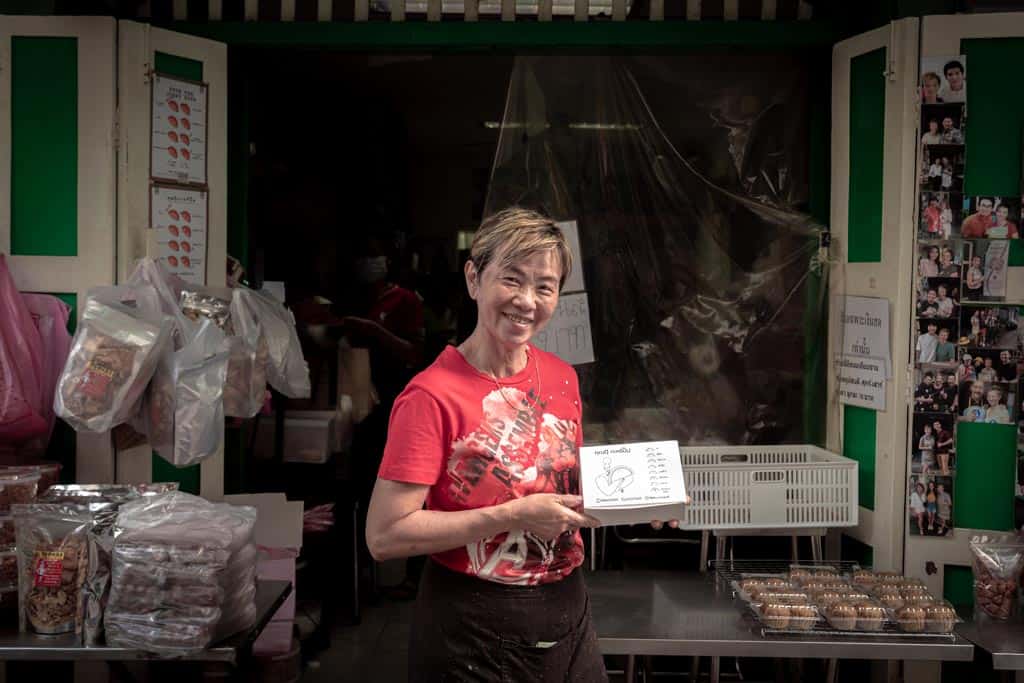
You may not expect it, but the street art in Chinatown is surprisingly good, and one of our favourite things to do was simply wander through the narrow alleyways looking out for the murals and paintings.
The area around Talat Noi has some of the best examples of Chinatown street art, so make sure you bring your camera with you and marvel at the talent of these artists.
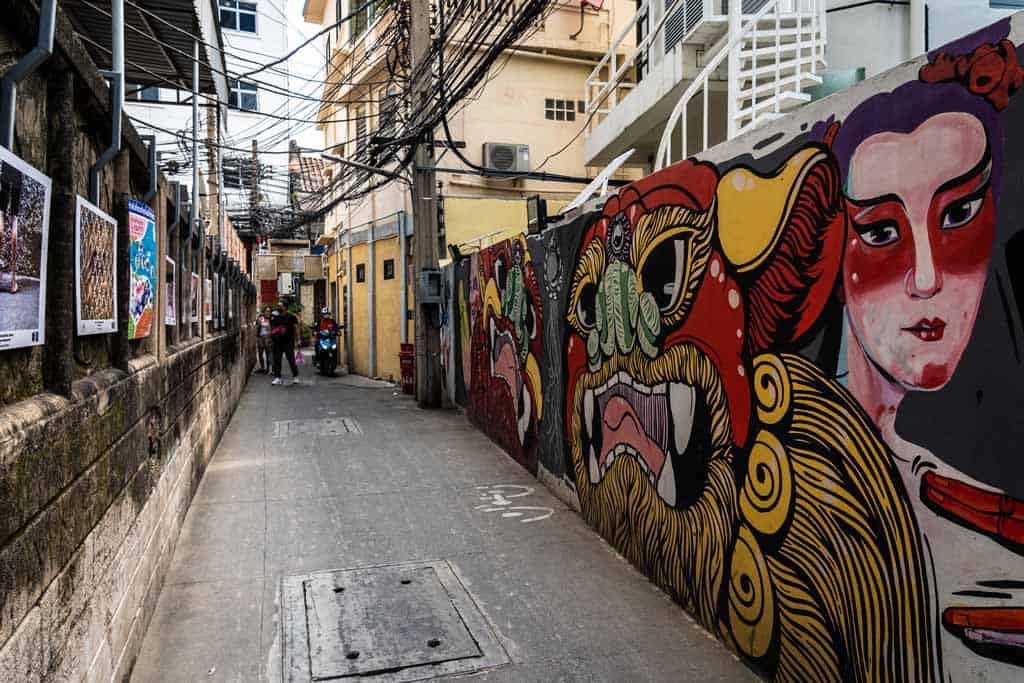
This 200-year-old building is one of the last beautifully-preserved treasures in Bangkok’s Chinatown, and supposedly the oldest private residence in the city.
This gorgeous courtyard house was constructed by a very prominent Chinese farmer in the 19th century and still belongs to his family.
A deep pool was built in the courtyard in 2004 and it now operates as a diving school, but the real appeal (if you’re not looking to do scuba in the middle of the city) is the intricate architecture inspired by the old Chinese community.
- Address: 282 Soi Wanit 2, Talat Noi, Samphanthawong, Bangkok
READ MORE: Wondering what else to do in Bangkok? Check out our perfect 3 days in Bangkok itinerary !
Nothing beats a 360-degree view, and if you’re looking the best one in Chinatown then head to Rise Bar on the rooftop of Luk Hostel .
Grab yourself a drink (they have some boutique Thai craft beers available!) and grab a seat on the balcony overlooking the Chao Phraya River and the speckled roofs of Chinatown.
You don’t have to be staying here to drink at Rise Bar, but stop by reception before taking the elevator to let them know you’re there.
- Address: 382, 384-386 Vanich 1 Rd, Chakkrawat, Samphanthawong, Bangkok
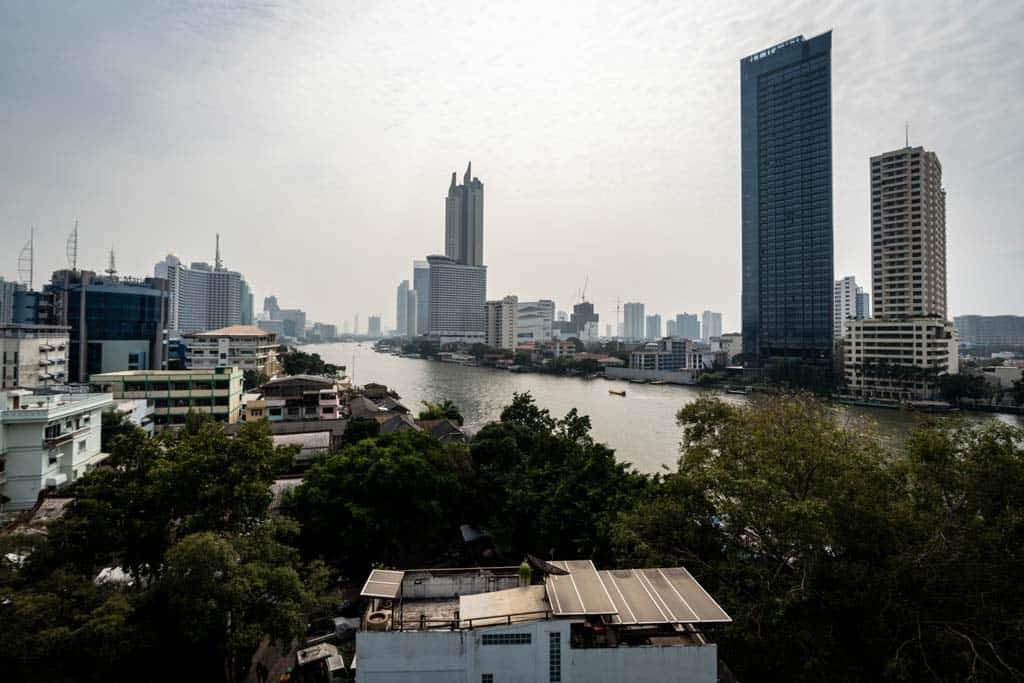
Bangkok is home to hundreds of funky cafes and bakeries, and if you’re the kind of person who loves nothing more than sipping on a freshly-roasted brew in a unique setting, then you cannot miss Hong Sieng Kong .
Built in an 200-year-old warehouse on the riverside of Talat Noi, Hong Sieng Kong recently opened to critical acclaim and instantly became the city’s go-to hipster cafe.
Hong Sieng Kong serves up a variety of baked goods and tasty coffee, and the best place to enjoy it is right here in their renovated grounds.
There’s all kinds of interesting antiques and artwork found around the warehouse, and if the sun is shining grab a table outside by the river.
- Address: Room 734-736, Wanit Soi 2, Bangkok
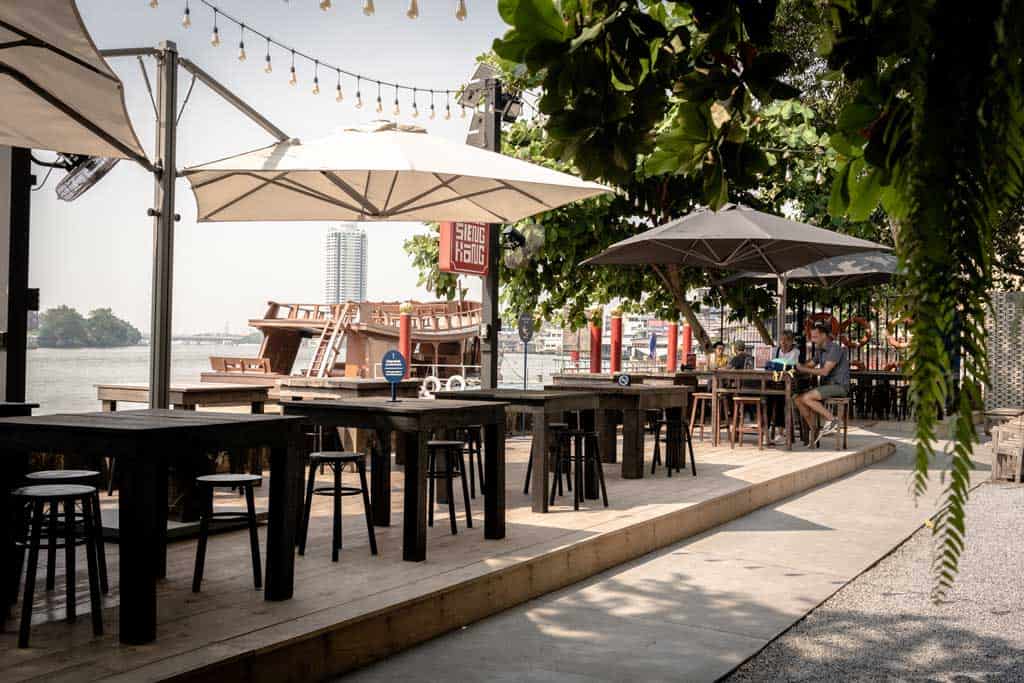
Thai people are renowned for their friendliness and hospitality, and you’ll find this in spades when walking around Chinatown.
Very much a local neighbourhood, the people who reside in Yaowarat aren’t exactly strangers to seeing tourists wandering through the side streets and alleys, but they love showing off their city.
Our guides Pum and Pizza did a wonderful job of introducing us to as many as possible during our walking tour, and as they are regulars there they have gotten to know quite a few of them very well.
We were welcomed into a blacksmith’s workshop (where Jarryd was promptly put to work smashing some hot iron), into a mechanic’s storefront to talk about the various tuk tuk parts he had for sale and even into a local seamstress’ shop to see how the talented lady made mesmerising patchworks.
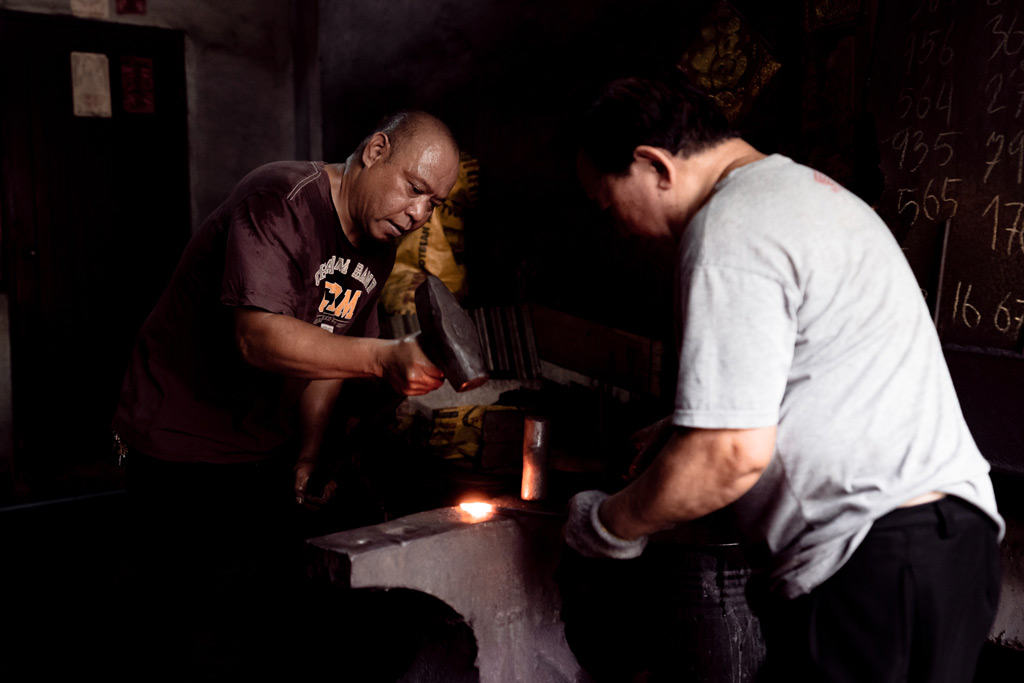
The best part was leaning how to make deep-fried spring rolls in one of the local lady’s homes, an experience that is not possible without a guide with you.
Joining a guided tour with HiveSters allowed us to not only communicate with the locals, but also learn more about the way they live and get a unique insight into exactly what life is like in Yaowarat.
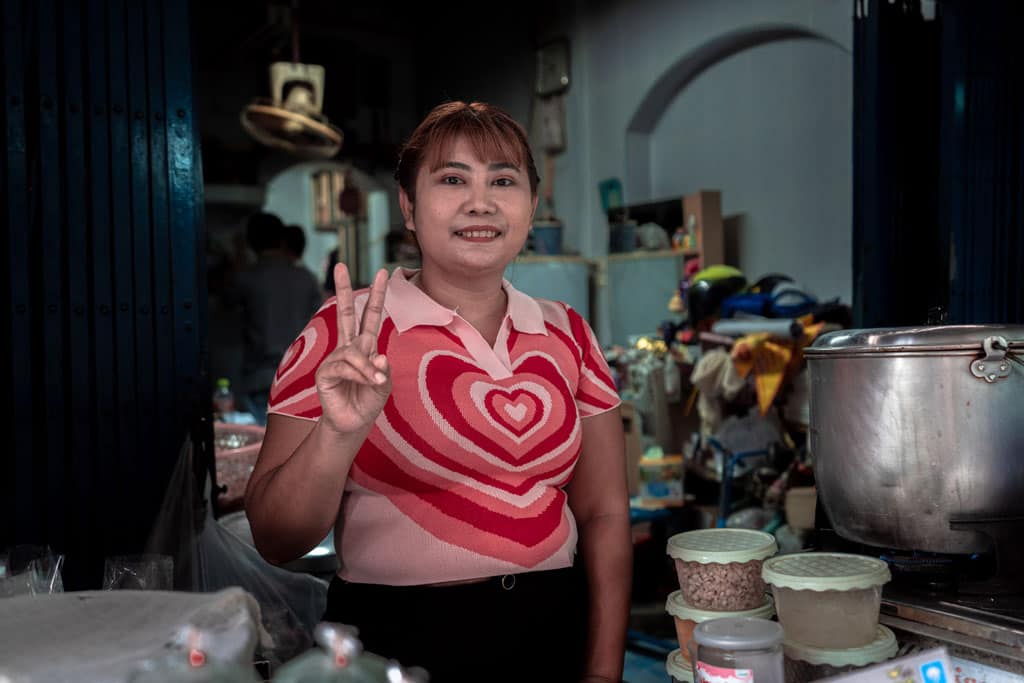
Chinese temples are truly a sight to behold, with their roaring dragons, red interiors and lanterns creating a design that is instantly recognisable.
Yaowarat has dozens of temples, both large and small, and you are welcome to enter almost all of them.
The Crocodile Temple, or Wat Chakrawatrachawat Woramahawihan as it’s formally known, is legendary for its crocs that supposedly were enclosed after eating young monks, and can be found on the edge of Chinatown.
Some of the other best places to visit in Chinatown are Sampeng Lane (Soi Wanit), the Flower Market and Yaowarat Road, which is the main street filled with shops selling household goods, food markets and souvenir stores.
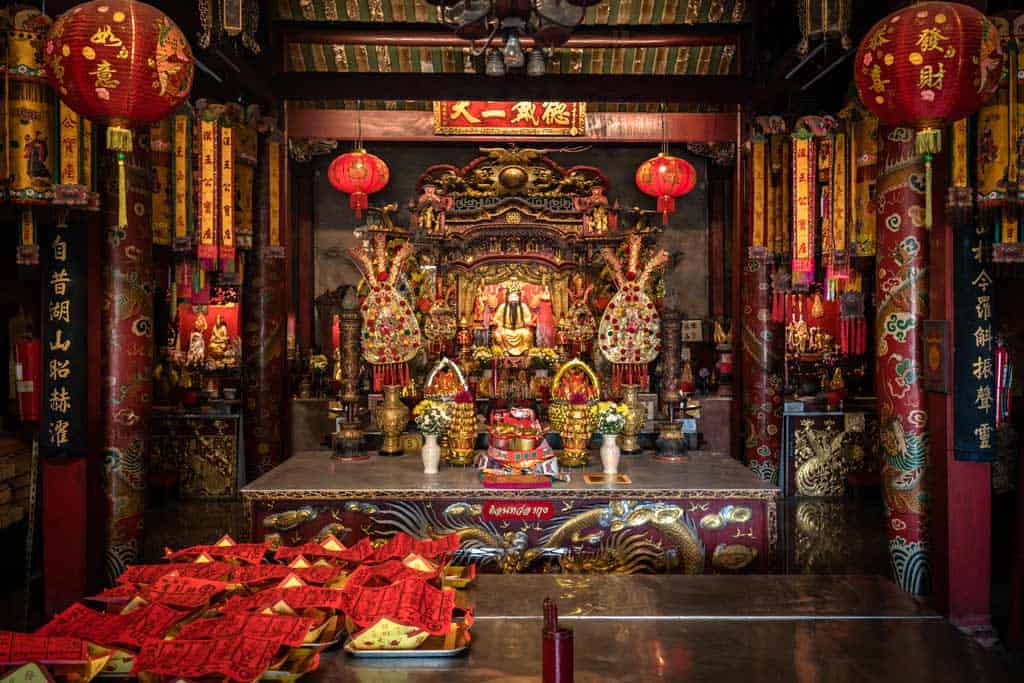
Chinatown in Bangkok – A Mini-Guide
Now let’s dive into some FAQs and information about Chinatown in Bangkok.
READ MORE: Here’s our comprehensive guide to travelling in Thailand to help you plan your trip!
If you’re wondering whether or not it is worth visiting Chinatown in Bangkok, the answer is yes, absolutely!
This part of Bangkok is truly amazing and unlike anywhere else in the city, and is now one of the largest Chinatowns in the world.
Filled with colourful alleyways, gorgeous Chinese temples, historic buildings, delicious street food and of course the famous Yaowarat Road, spending a day in China Town is a must-do during your visit to Bangkok.
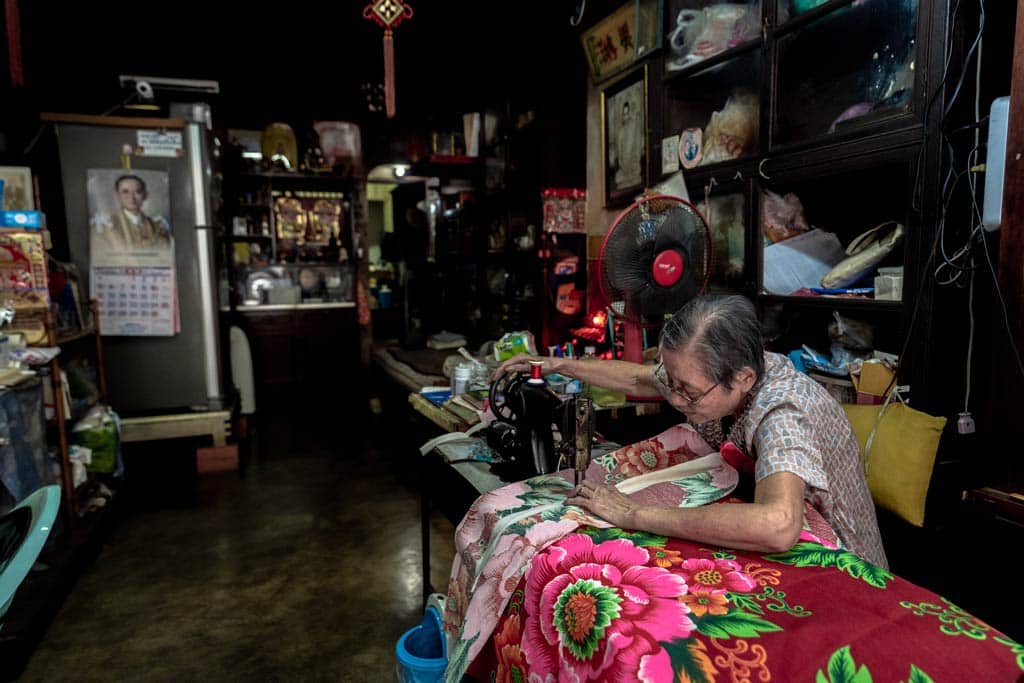
One of the best parts about walking around Chinatown is learning about its captivating history, which is one reason we highly recommend going on a guided tour.
In 1767 King Taksin brought in thousands of Taochew immigrants from China to work as merchants in his new Thai capital of Thonburi.
They settled on the east side of the Chao Phraya River opposite his palace, where they formed a thriving community.
In 1782 King Taksin was ousted during a coup and the nation’s General built the new Grand Palace where the Taochew lived, forcing them to relocate to the swampy area of Sampheng.
It was meant to be a way to suppress the Taochew, but being as industrious as they were, they soon started utilising the Chao Phraya River to bring in fresh produce and goods, turning Sampheng into a bustling trading hub with intricate Chinese temples and food markets.
Over the years Yaowarat morphed into one of the busiest neighbourhood’s in Bangkok, and while it is considered a tourist attraction for thousands of visitors, it has not lost its authentic, local atmosphere.
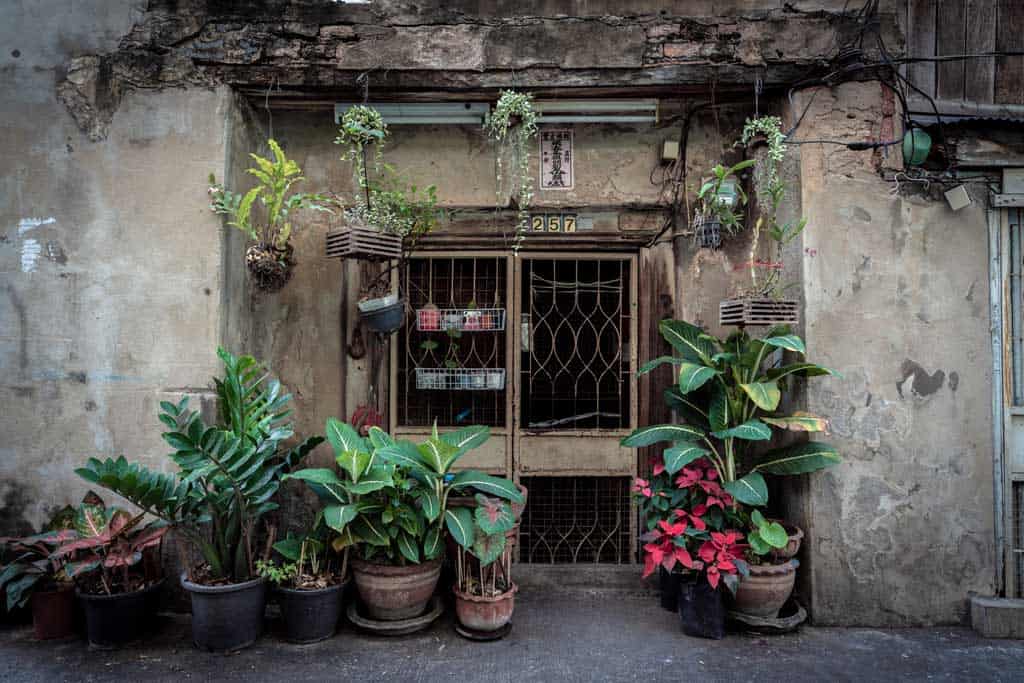
How to Get to Chinatown Bangkok
There are a number of ways to reach Chinatown Bangkok, and it all depends which direction you are coming from.
Chinatown can easily be reached by boat, MRT and taxi.
You can catch one of the local ferries to Chinatown. The best way to get there is to get off the ferry at the Ratchawong Pier.
From the Ratchawong Pier ferry station you can access Yaowarat Road.
Alternatively you can catch the ferry to Marine Department Pier which is near So Heng Thai Villa, Talat Noi and other small temples.
If you want to get to the Flower Market, take the boat to Memorial Bridge Station. It is a little off the beaten track of the other attractions in Chinatown but if you are into flowers this is a place to start and walk to the other attractions from here.
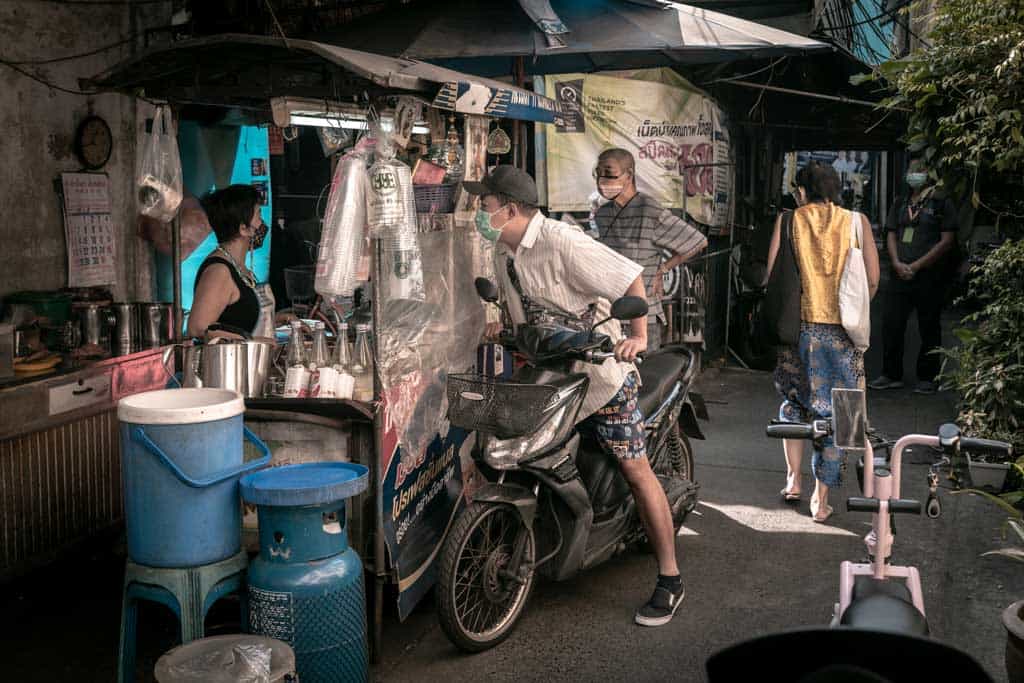
The MRT is another great way to get to Chinatown Bangkok. Take the MRT to Hua Lamphong station and from here you are a short walk to Wat Traimit and the China Gate.
Just note that Chinatown Bangkok is not connected to the BTS Skytrain. You will have to transfer to the MRT if you are on the BTS lines.
Getting a taxi there is another great way if you are not too far from Chinatown Bangkok, and can be cheap if you know what you’re doing.
Hot tip – Always ask for the driver to use the metre. There are some cheeky drivers that will refuse and instead offer a fixed price, which is always heavily inflated. Please do not support these drivers.
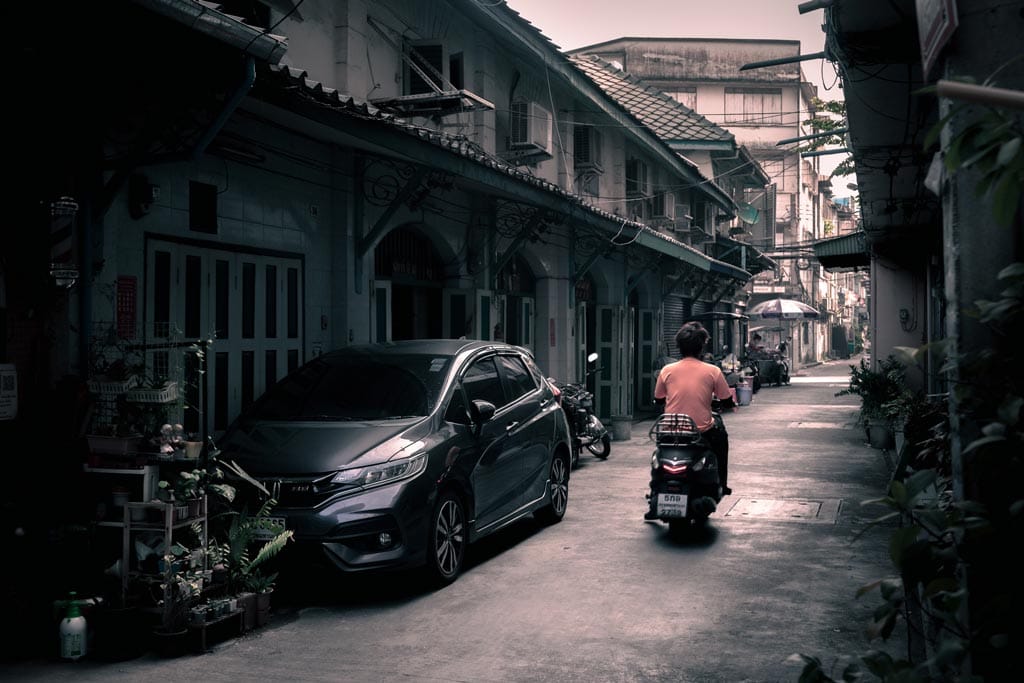
While you don’t need to book a guided tour to explore Chinatown, we highly recommend jumping on one.
You’ll gain so much more from the day by learning about the history, finding secret little alleyways that most tourists miss and knowing exactly where to find the best food.
We went out with HiveSters and highly recommend their ‘Hidden Chinatown’ tour.
You’ll be accompanied by an experienced, English-speaking guide who knows the area around Talat Noi and Chinatown like the back of their hand.
In addition though the company operates as a social enterprise with a mission of preserving Thai culture and empowering local people.
They are experts in sustainable tourism , even working as consultants for other businesses in Thailand, and donate their profits into charitable endeavours.
HiveSters also run a number of tours in other places around Thailand, including Chiang Mai , Ayuthaya and Phuket .
To book a tour with HiveSters go directly through their website: https://hivesters.com/contact/
Disclaimer: Our walking tour of Chinatown in Bangkok was made in partnership with the Tourism Authority of Thailand. All thoughts, opinions and dozens of curry puffs consumed are, as always, our own.
Alesha and Jarryd
Hi, We’re Alesha and Jarryd!
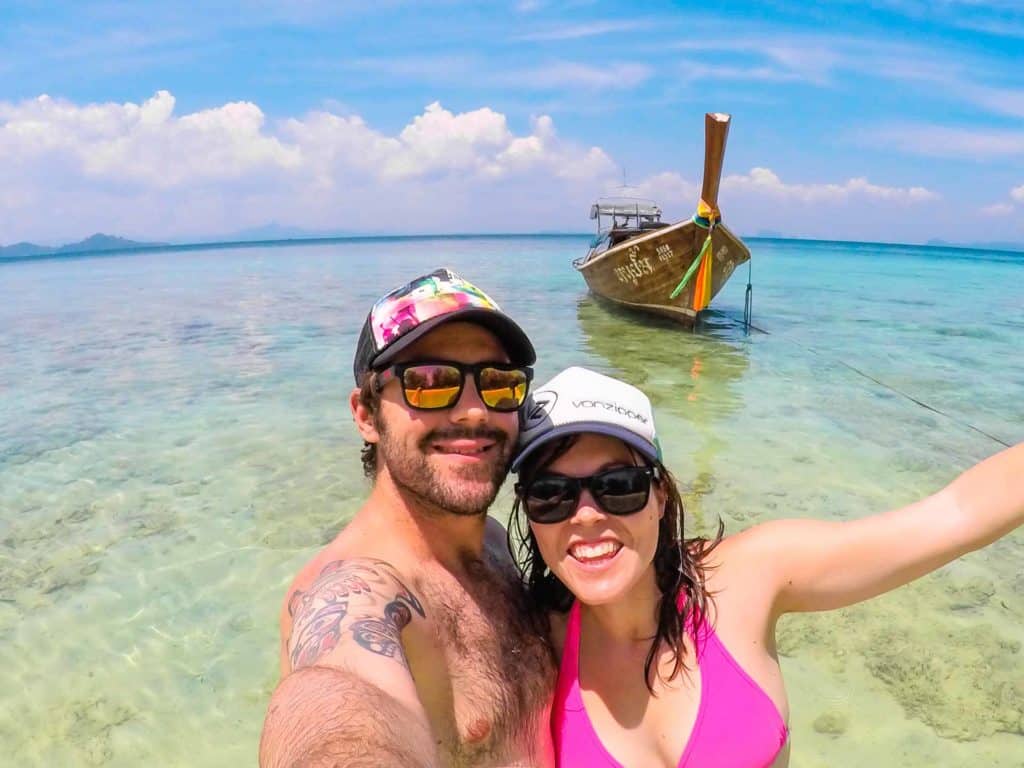
We’ve been traveling the world together since 2008, searching for the planet’s best destinations and adventures.
Love Travel?
Sign up for our free weekly newsletter for the best travel tips, ideas and deals!
We respect your privacy. Unsubscribe at any time.
READ MORE...
Coral Geographer Review: A Deep Dive of Australia’s Top Expedition Ship
GoPro HERO 13 Review – The Ultimate Camera Guide [2024]
Quark Ultramarine Review – Best Polar Expedition Ship [2024]
Related Posts
Gopro hero 9 review – is it still worth it in 2024, 25 awesome things to do in rarotonga, cook islands (2024 edition), 18 awesome things to do in hot springs, arkansas [2024 guide], things to do in battambang – not just the bamboo train, leave a comment cancel reply.
Save my name, email, and website in this browser for the next time I comment.

- DIY TRAVEL GUIDES
- FAMILY TRAVEL TIPS
- UNIQUE FAMILY HOTELS
- DIGITAL NOMAD FAMILIES
- WORLDSCHOOLING
- MALAYSIA ITINERARIES
- THAILAND ITINERARIES
- BALI ITINERARIES
- CAMBODIA ITINERARIES
- VIETNAM ITINERARIES
- ISRAEL ITINERARIES
- JORDAN ITINERARIES
- PHILIPPINES
- FAMILY FRIENDLY HOTELS
- FLYING WITH KIDS
- BUDGET TRAVEL TIPS
- BEST TRAVEL GEAR
- LUXURY HOTELS
- VILLAS WITH PRIVATE POOLS
- BUDGET HOTELS
START HERE | , THAILAND , TRAVEL DESTINATIONS | , WHERE TO GO
Chinatown bangkok – complete guide 2024.

Table of Contents
In this article we are going to tell you everything you need to know about Chinatown Bangkok in 2024. We will tell you everything you need to know: from where to eat, what to see, how to get around, and the best places to stay in Chinatown Bangkok. We are going to take you through an epic self-guided walking tour – step-by-step and bite-by-bite!
Chinatown is one of our favorite areas to explore in Bangkok. It is packed with amazing food, beautiful culture, and plenty of lovely people. We’re excited to share our knowledge and top tips with you to make sure you don’t miss a thing.
We’ve stayed in Bangkok many times over the years, and we have a particular love for Chinatown in Bangkok. In our opinion, this area offers the perfect balance of bustle, amazing food, and a beautiful fusion of two unique and fascinating cultures. There is so much to see and do in the area. If you get a chance to stay in Chinatown Bangkok, we highly recommend it. But even if you are not staying in the area, it is still possible to explore and make the most of this unique destination. We hope that our recommendations and this information will help you make the most of your time.
GET EQUIPPED – See all of the best bits – no need to plan or navigate – book this tour and get a local expert guide to show you all of the BEST parts of Chinatown Bangkok and it is amazing value for money. We recommend this awesome Chinatown Bangkok Tour on Get Your Guide 🙂
PLAN YOUR TRIP – Don’t miss our guide to The BEST areas to stay in Bangkok
What is Chinatown Bangkok?

Chinatown in Bangkok, also known as Yaowarat, is one of the city’s most vibrant and historic neighborhoods. It is a bustling district located in the Samphanthawong district of Bangkok and is home to a large Thai-Chinese community. Chinatown is renowned for its rich cultural heritage, bustling markets, delicious street food and distinctive architecture.
- Street Food: Yaowarat is famous for its street food stalls and restaurants that serve a wide variety of Chinese and Thai dishes. Visitors can savor popular dishes such as dim sum, roasted duck, bird’s nest soup, and seafood, among others.
- Markets: The area is packed with markets and shops selling everything from traditional Chinese herbs and medicines to gold jewelry, textiles, and souvenirs. The Sampeng Market is a popular destination for shoppers looking for great deals on a wide range of products.
- Temples: Chinatown is home to several beautiful Chinese temples, including Wat Mangkon Kamalawat (also known as Wat Leng Noei Yi). These temples are important cultural and religious centers and are adorned with intricate decorations and sculptures.
- Festivals: During Chinese New Year and other traditional Chinese festivals, Chinatown comes alive with vibrant decorations, parades, and cultural performances.
- Architecture: The architecture in Chinatown is a mix of traditional Chinese and Thai styles. You’ll find ornate shop houses, red lanterns, and intricate facades that add to the neighborhood’s unique charm.
- Culture and Heritage: Chinatown has a rich cultural heritage, and it’s a great place to explore the history of Bangkok’s Chinese community. You can learn about their contributions to the city and experience their customs and traditions.
Chinatown in Bangkok is a must-visit destination if you want to experience the fusion of Thai and Chinese culture, indulge in delicious street food, and explore a historic and vibrant neighborhood. It offers a unique glimpse into the diversity and richness of Bangkok’s cultural tapestry.
Love Chinatown? Don’t miss Wat Saket in Bangkok – it is only around 15 minutes from Chinatown by taxi and you get one of the BEST views of Bangkok!
Don’t miss our family adventures in Chinatown Bangkok
When is the best time to explore Chinatown Bangkok?

Don’t visit Chinatown too early. Lots of local cafes and shops are not open until around 9am. The evening is a wonderful time to explore Chinatown Bangkok. In the evening the markets come to life and the streets are relatively cool and bustling.
Chinatown Bangkok walking tour map
One of the best ways to see and experience Chinatown in Bangkok is to do a walking tour of the area. You can either book yourself onto a tour and go with a local guide. Alternatively, we have shared a self-guided walking tour route, so if you are unable to book yourself onto a tour, you can follow our Chinatown walking tour route and experience some of the best bits.
Total distance 1.6km
Time for walking tour 1 – 2 hours (depending on stops)
Chinatown Bangkok walking tour highlights
This is a self-guided walking tour, which allows you to see and experience some of our favorite highlights, including places to stop for epic food, interesting temples, and other fascinating shops and market streets.
We have tried to keep the route relatively short (around 1.6km or 1 mile). WIthout stopping this would take around 20 minutes to walk. The route does have a few detours that are worth taking (we have marked these on the map).
We recommend starting from the Wat Mankong MRT station (MRT Blue line). This Subway station is right in the heart of Chinatown Bangkok and allows easy and convenient access to the best markets, shops and cafes.
Looking for a guided tour. Don’t miss this amazing Sights & Bites tour of Chinatown Bangkok on KLOOK
1 Lee Ti Miew Temple

Start by walking north along Phlap Phla Chai Road until you see Lee Ti Miew on your left. This is a small artistic and colorful and ornate Chinese Temple, plenty of local food outside. You can often see Buddhist monks in this temple. Locals also attend this temple to burn incense and bring offerings. Remember to dress respectfully if you wish to explore a local temple in Bangkok.
2 S’Whichy dessert pies

Tasty dessert pies with tempting and creative fillings. Cost ranges between 20baht – 30baht.
3 Blue Water Cafe

Chinese-Thai architecture. Traditional Chinese shaved ice desserts.

4 Char Siew Pork Rice

Delicious, fresh, traditional and super local dish – chinese red char siew pork and rice served with spring onions, boiled egg and sweet gravy. They also served Chinese steamed chicken. Friendly local experience 50 baht. This one is open early – a great spot to experience an authentic Bangkok breakfast.
5 The Chinese Tea Shop

Free tea samples, served as a traditional tea ceremony. Very lovely staff. You can also buy tea, Chinese ornaments and traditional tea sets.
6 Kuan Yim Shrine
Small colourful Chinese shrine with Chinese red lanterns.
7 Dragon Cafe

Chinese Thai noodle dishes with Wonton and bubble teas. Creative and nice atmosphere. On the expensive side dishes range between 50 baht – 150 baht.
8 Hidden Alley & Traditional Chinese Ornaments

Small covered hidden alley. Hard to spot – you could easily walk past this alley. This short alley has some traditional antique Chinese gift shops. Worth a look whether you’re planning to shop or not!
9 Wat Mangkong Kamalawat (Wat Leng Noei Yi)

At the heart of Chinatown don’t miss Wat Mangkong, a unique and distinctive Chinese temple with traditional Chinese art and architecture.
10 Traditional Chinese Pharmacies

Don’t miss the traditional Chinese Medicinal herb shops full of curious smells and dried herbs.
11 Explore the food market street

Take a detour along the food market street (Itsaranuphap Alley). This small alley is for pedestrians only (and the occasional motorbike!). There are plenty of beautiful and fascinating local food stalls along the street. The perfect chance to dive in and try something new!
12 Hong Kong Dim Sum

While your exploring the food market on Itsaranuphap Alley check out Hong Kong Dim Sum (close to the north entrance to the alley). This is a lovely dim sum cafe with indoor seating. They serve a range of tempting dishes including pork and shrimp dim sum, Bao (steamed buns), crispy shrimp wonton and fried noodles. Most dishes range between 20 baht – 50 baht and they also serve hot drinks. We highly recommend the tempting Lava buns with a creamy custard filling.
13 MezzoX Drip Coffee

As you walk back along Charoen Krung road towards Wat Mankong MRT station check out MezzoX Coffee. This is an up market local coffee shop serving a range of impressive drinks including drip coffee, frappuccinos, smoothies and juices. This small quaint coffee shop has an east Asian interior design theme and it has a cool calm atmosphere with A.C. The perfect spot to cool off, refresh and relax after the hot intensity of Chinatown.
14 Traditional Chinese Bakery

On Charoen Krung road you can also find a couple of traditional Chinese bakeries (close to the MRT station). They sell pastries filled with bean paste, fruit and salted egg. Try classic Chinese moon cakes and drinks such as sour plum juice and lychee juice.
What are the best ways to get to Chinatown in Bangkok?
The best way to get to Chinatown in Bangkok depends on your budget, need for convenience, and time.
1 Subway MRT

In our opinion, the best way to get to Chinatown Bangkok is to use the Bangkok Subway system. You need to take the blue MRT line and stop at Wat Mankong station (on the south of the loop). This station is situated in the bustling heart of Chinatown, very close to some of the best markets and cafes. The MRT in Bangkok generally costs 30-50 baht. Kids under 100cm are free, and kids 100cm – 150cm are half price. To use the Bangkok MRT train, you need to buy a token. You can either purchase your token from a ticket machine at any station. MRT stations also have staffed ticket offices where you can buy your MRT token.
2 Taxi (Grab, Bolt app, or local taxi)

Taking a local taxi around Bangkok is a surprisingly cheap way to get around, and we highly recommend using the Bolt taxi app if you are looking for the best prices on local taxi rides. You can also use a taxi app called Grab; however, Grab taxis are generally at least 20% more expensive than Bolt. One of the biggest disadvantages of taking a taxi in Bangkok is the traffic. Depending on the time and your route, Bangkok can be very congested, and taxi rides could be painfully slow. Your taxi driver may offer to take you along the Bangkok highway. This may reduce journey times a little bit, but you will also need to pay an additional fee on top of the journey price (around 50 baht).
To use a taxi app in Bangkok, you will need to have a local SIM card and mobile data. You need to download the app and use your local phone number to register an account. Once your account is set up, you can order taxis online and opt to pay in cash. We have found this to be a very efficient and convenient way of getting taxis.
If you don’t have a local SIM card with mobile data, there is still the option of flagging a taxi at the side of the road. If you do this, we recommend that you insist on them using the taxi meter rather than trying to negotiate a price.

Taking a tuk-tuk is a fun, iconic, and exhilarating way to travel around Bangkok. However, it is worth recognizing that tuk-tuks can be quite expensive and are likely to cost more than a local taxi, and certainly more than an MRT train. Expect to pay at least 100 baht for a short tuk-tuk ride (a few kilometers). Longer tuk-tuk rides are likely to cost at least 200-300 baht. If you choose to take a tuk-tuk in Bangkok, you are really paying for the experience and the novelty. You can still find tuk-tuk drivers waiting all around Bangkok, especially around more popular tourist spots and temples.
Top tips for exploring Chinatown Bangkok

Firstly, we recommend that you bring an umbrella along with you. Bangkok is prone to sudden rainy downpours, especially in the rainy season. However, even on a hot, dry day, the sun can be intense, and an umbrella is great for sun protection.
Secondly, we recommend that you have offline maps available or use a SIM card with mobile data so that you can keep track of your route through Chinatown Bangkok.
Thirdly, if you are planning to explore the temples in Chinatown Bangkok, we do recommend that you dress modestly. It is important that your shoulders and knees are covered. If you are wearing a vest top, we recommend that you also bring a scarf to cover your shoulders.
And finally, bring cash with you to buy snacks, drinks, and food as you walk around Chinatown Bangkok. Many places that you want to eat at will not accept cards, so you will need to use cash to pay.
What are prices like in Chinatown Bangkok?

In general, Thailand is a very cheap country, and prices are likely to be much lower than in your home country. However, it is worth recognizing that Chinatown Bangkok is more expensive than other areas of Bangkok. So you are likely to pay a little more for food and drinks in this area. For example, a bottle of orange juice on the streets in Bangkok normally costs around 20 baht. In Chinatown, it normally costs 40 baht for a bottle of orange juice. Street food such as noodle soup normally costs 30-40 baht and is likely to cost 50-80 baht in Chinatown Bangkok. These prices are just to help give you a feel for Chinatown Bangkok. You can always try bargaining; just remember to stay positive and keep it friendly.
What are the best places to stay in Chinatown Bangkok?
1 noir cafe and hostel.

Price range per night: £5 – £25
Trendy traditional heritage style hostel. Great value for money. Dorm rooms available. They also have a private family triple. Great location and one of the cheapest guest houses in Chinatown. There is also a stylish cafe here too!
2 Norn Yaowarat Hotel

Price range per night: £15 – £230
Light clean stylish pastel hostel with clean minimalist interiors. Comfortable place with Japanese vibes. Amazing split tier family room with a private bathroom can sleep up to 5 people.
3 Oldthaiheng Hotel

Price range per night: £50 – £170
Super spacious, clean, stylish, contemporary and minimalist. Large windows allow plenty of natural light. We love the subtle east asian designs here. They have a family suite that sleeps up to 4 people. Great location near July 22nd roundabout.
4 Hotel Royal Bangkok

Price range per night: £35 – £375
Luxurious 4 star hotel. Great facilities including restaurant, bar and rooftop swimming pool. More traditional hotel interiors. They do have a family room that can accommodate up to 3 people with a double bed and a sofa bed.
5 Shanghai Mansion Bangkok

Price range per night: £60 – £370
Super stylish East-Asian hotel with decadent regal suites and great facilities. Amazing facilities including a spa & wellness centre, restaurant and bar. This is a very unique and stylish property.
Life loving, adventure chasing, Mum of 3 who loves travel. Over 10 years of travel writing experience. Emma now loves to give the best tips to help other travel loving parents plan adventures with their kids. Whether you need to find the best accommodation or just need to know how to pack your bag Emma is that travelling mum who love to help you.

- Privacy Overview
- Strictly Necessary Cookies
- Privacy Policy
This website uses cookies so that we can provide you with the best user experience possible. Cookie information is stored in your browser and performs functions such as recognising you when you return to our website and helping our team to understand which sections of the website you find most interesting and useful. More information about our Privacy Policy
Strictly Necessary Cookie should be enabled at all times so that we can save your preferences for cookie settings.
If you disable this cookie, we will not be able to save your preferences. This means that every time you visit this website you will need to enable or disable cookies again.
More information about our Privacy Policy
Chinatown Self-Guided Walking Tour in Bangkok
Explore the Heart of Bangkok's Chinatown
Travel Show Map Share
Exploring Bangkok’s Chinatown: Temples, Markets, and Heritage
Begin at the Chinatown Gate , the grand entrance to Bangkok’s Chinese community, and a symbol of the rich culture you'll explore.
Visit Wat Trai Mit , home to the magnificent 5.5-ton Golden Buddha, a must-see for its beauty and historical significance.
Discover the serene Kuan Yim Shrine at the Thian Fah Foundation, dedicated to the goddess of mercy, Kuan Yim.
Wander down Yaowarat Road , the bustling heart of Chinatown, known for its street food, gold shops, and vibrant atmosphere.
Take a break at Shanghai Mansion , perfect for people-watching and enjoying a cold beer in a charming old Shanghai setting.
Explore Talat Kao , an old Thai-Chinese market where you can experience local life and shop for unique goods.
Visit Leng Buai Ia Shrine , the oldest Chinese temple in Bangkok, dating back over 300 years.
Explore Wat Mangkon Kamalawat , the largest Chinese Buddhist temple in Bangkok, known for its dragon motifs.
Pause at Wat Kan Matuyaram , a quiet temple honoring Kan’s mother, reflecting Chinese cultural values.
Stop by Tang Toh Kang , the oldest gold shop in Bangkok, showcasing the deep Chinese influence on the city's gold trade.
Stroll through Sampheng Market , a lively wholesale market offering everything from fabrics to electronics.
Visit the Siri Guru Singh Sabha Gurdwara , the second-largest Sikh temple outside India, representing Bangkok’s diverse religious heritage.
Conclude your tour at Wat Ratchaburana , a peaceful temple with beautiful murals and a calming atmosphere.
End your walk at the King Rama I Monument , a tribute to the founder of the Chakri dynasty, set in a tranquil park.
Wat Mangkon Kamalawat
Dragon Flower Temple (Wat Leng Noei Yi)
One of the famous temples in Yaowarat, Wat Mangkon Kamalawat offers many religious activities in a great atmosphere. The temple has better rules than many others, as it doesn't allow the use of incense, which usually produces a lot of smoke. This makes the experience more pleasant for visitors.
08:00-16:30
Wat Trai Mit Witthayaram Worawihan
Golden Buddha Statue
Wat Trai Mit Witthayaram Worawihan is a very beautiful and peaceful Buddhist temple. The top floor houses the world’s largest solid gold Buddha statue, which exudes timeless beauty and spiritual tranquility. The interior is breathtaking, offering a serene atmosphere that reflects Thailand's rich cultural heritage and religious devotion. This temple is a must-visit if you are in Bangkok.
08:00-17:00
Shanghai Mansion Bangkok
Spa Burasari
Exquisite Vintage Decor and Exceptional Service
I absolutely loved the exceptional service and beautifully decorated interior of this hotel. The rooms were amazing, quiet, and perfect for a romantic getaway. The staff were incredibly nice and attentive, making us feel like royalty during our stay. Overall, a stunning experience that I would rate 10 out of 10!
Siri Guru Singh Sabha Gurdwara
Second Largest Shikh Temple outside of India
I happened to walk in just as the Ardas (prayers) began. It was a beautiful and moving experience. I highly recommend visiting this place if you're in Bangkok. I would definitely go back again!
06:00-20:00
The Chinatown Gate
Iconic Gateway to Bangkok's Vibrant Chinatown
If you're looking to experience Bangkok's vibrant Chinatown, the Chinatown Gate on Tri Mit Road is a great starting point. To avoid the weekend crowds, consider visiting during the weekdays. The area is packed with food stalls offering a variety of delicious street food from different Asian cuisines, making it a must-see and must-visit spot.
2'021 4.4 Picture
Yaowarat Road (Chinatown’s main street)
A Culinary and Cultural Odyssey on Yaowarat Road
8'892 4.3 Picture
Sampheng Market
Sampheng Market, nestled in the alleys of Chinatown in Bangkok, offers a retail haven with a variety of items such as accessories, toys, and shoes. Many shops are equipped with air conditioners, providing a comfortable shopping experience regardless of the weather.
09:00-17:00 | 23:00-05:30
Old Thai-Chinese trading community
This historic market, one of the oldest in Bangkok, offers a variety of ready-made specialties such as rainbow lobster balls, seafood sausages, and fermented cabbage. Opening at 4 a.m., it's a food haven with dishes crafted over decades. The market also sells prayer goodies, and while parking is limited, underground trains and taxis are convenient options.
05:00-18:00
Wat Ratchaburana Ratchaworawihan
Wat Ratchaburana Ratchaworawihan is an incredible temple in Bangkok, offering a peaceful courtyard perfect for a quiet stroll. While the main buildings were closed during my visit, the serene atmosphere and beautiful surroundings make it highly recommended. It's located near Ban Chong Thong, the oldest district of Bangkok, adding to its historical charm.
Kuan Yim Shrine
Thian Fah Foundation
Kuan Yim Shrine is my favorite Buddhist temple in Bangkok. Its beautiful decorations and peaceful ambiance make it a must-visit spot in the bustling area of Samphanthawong.
Wat Kan Matuyaram
Temple for Kan’s Mother
King Rama I Monument
A giant statue of King Rama I, located within walking distance from the flower market and Sky Park, sits in a well-maintained park. The open area is perfect for relaxing, though the fountain at the entrance lacked water during my visit. The statue itself is clean and well-kept, making it worth a visit if you're nearby.
Leng Buai Ia Shrine
The Oldest Chinese Temple in Bangkok
07:00-17:00
Tang Toh Kang
The Oldest Gold Shop in Bangkok
We visited several gold shops in Chinatown, but Tang Toh Kang stood out. The experience here was the best, with excellent customer service and top-notch gold quality. Highly recommended!
09:30-16:00
- Skip to main content
- Skip to primary sidebar

Destinations
- Plan Your Trip
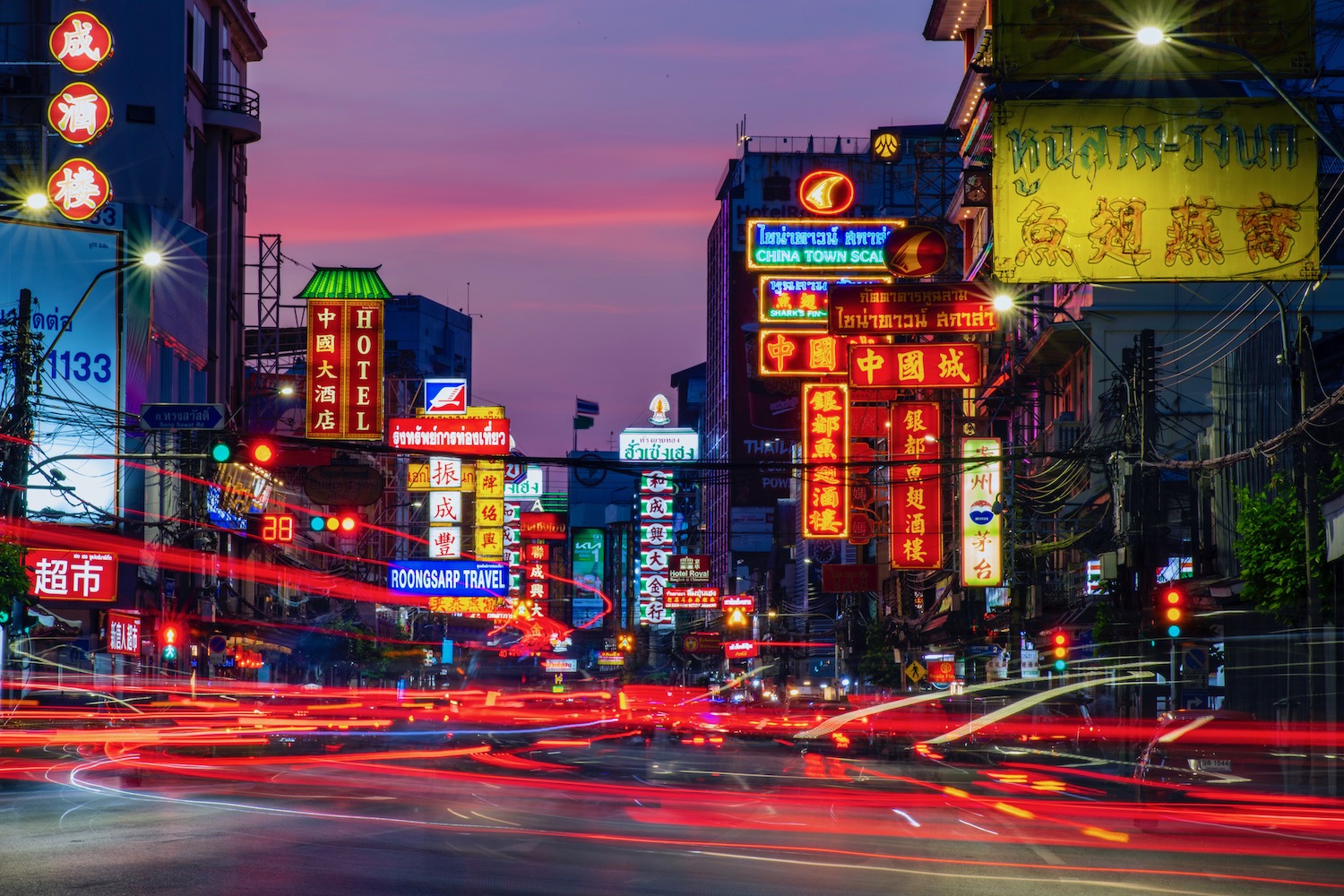
The World’s Best Chinatown
July 31, 2024 by Robert Schrader Leave a Comment
Bangkok is an unmistakably Thai city, but it’s also rather Chinese in a lot of ways. And not just because of how popular it is among tourists from China, though that certainly contributes to it.
Indeed, it’s the fact that a not-insignificant percentage of Thais are of Chinese descent, which you can observe throughout the capital at temples, in restaurants and at shops. And, more to the point of this post, in Yaowarat, aka Bangkok’s Chinatown.
Follow my Bangkok Chinatown walking tour exactly, or use it as a jumping-off point for your own explorations. No matter which tack you take, I have a feeling you’ll soon feel inspired to check the area out.
How to Get to Bangkok’s Chinatown
Before I delve anymore deeply into my Bangkok Chinatown itinerary, I should explain how to get there. Chinatown is easy to reach, no matter where you’re coming from:
- The most direct way is to ride the MRT Blue Line to Wat Mangkon and follow the signs into Chinatown. This convenient line has stops in Silom , Sukhumvit and at Hua Lamphong Railway Station .
- You can also (kind of) get there by BTS . Specifically, by riding to Saphan Taksin , where you can either get a motorbike or tuk-tuk up Charoen Krung Road into Chinatown , or ride a Chao Phraya Express ferry to Ratchawong pier.
- If you’re sightseeing in the old city of Rattanakosin , meanwhile, simply go by tuk-tuk , as this is the quickest and most direct way.
TIP: If all else fails, you can type “Yaowarat Road” into the Grab application to reach Chinatown from wherever in Bangkok you happen to be.
Where to Go in Bangkok’s Chinatown
Wat traimit.

Also known as the “marble temple,” Wat Traimit is located on your way to Chinatown from Hua Lamphong Station, or just south of the main “strip” if you’re already there. While the temple towers over most of the rest of what’s around it, another landmark you can use to find it is the Chinatown Gate .
Yaowarat Road
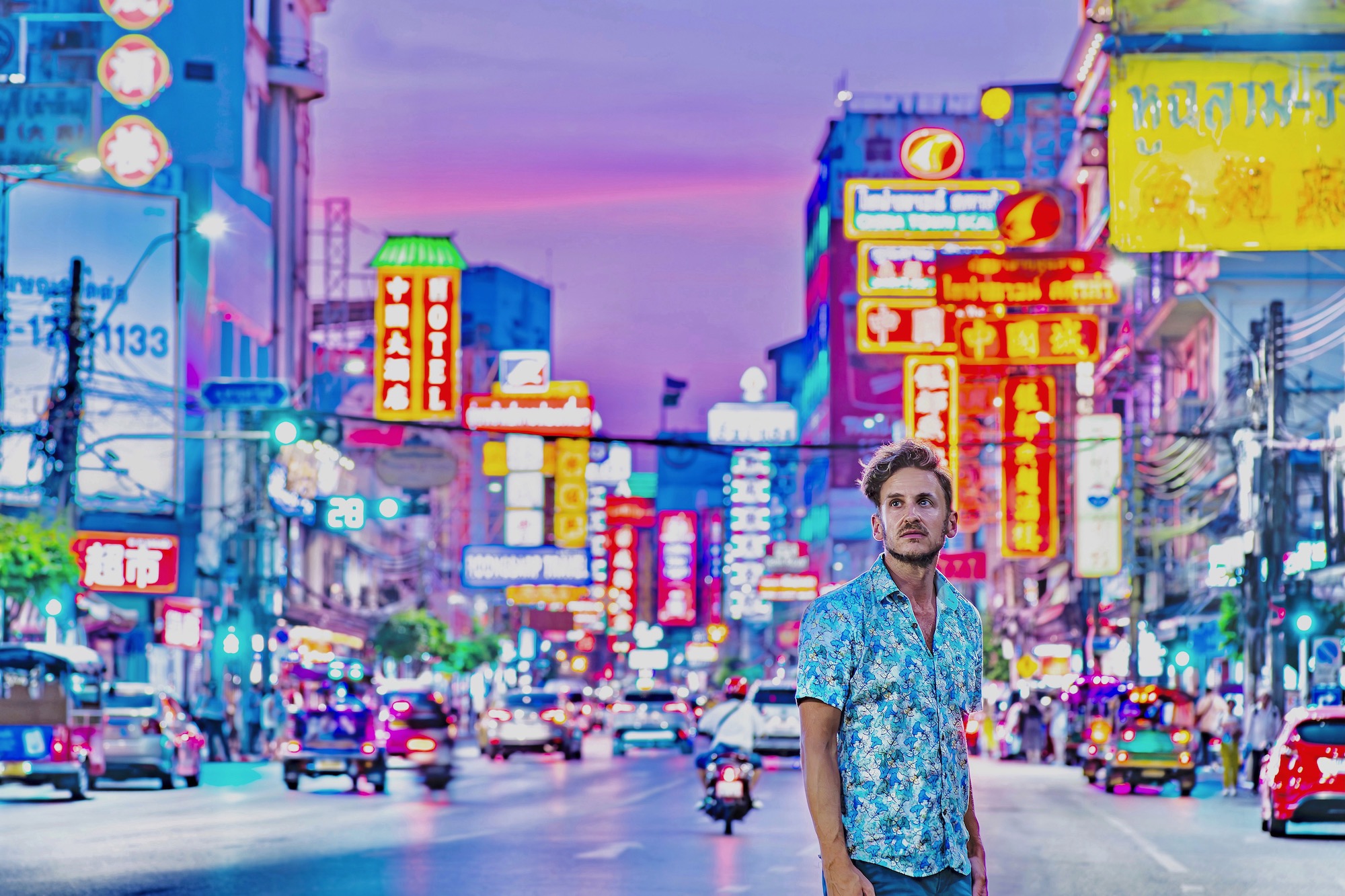
Whether you take a Yaowarat walking tour, go by bike or simply explore independently, neon-lit Yaowarat Road is in the heart of the action. It’s here where you’ll find the district’s famous street food, whether you eat pa tong go donuts in the morning, or stir-fries and seafood at night.
Chinatown’s back alleys

The bad news? Going off the beaten path in Chinatown can easily result in you getting lost. The good news? This is exactly how you find the “real” Chinatown, even if determining when you’ve found it can be difficult—there aren’t a lot of “attractions” here. If you don’t come here with a tour, come without an agenda.
Chao Phraya riverfront

Any Yaowarat itinerary worth a damn will take you along the riverfront, whether that’s arriving here by Chao Phraya Express boat from Sathorn Pier , or actively engaging with the river, be that during Loy Krathong or simply at sunset one night. The river is inextricable from Chinatown—and not just during frequent floods!
Pak Khlong Talat flower market

While Pak Khlong Talat flower market is toward the northern boundary of Chinatown—some people argue it’s not even really part of Chinatown—I try and include it in the Chinatown portions of the trips I plan for my clients. Certainly, the fact that it’s open 24 hours a day make it more inviting to visit.
Where to Stay in Bangkok’s Chinatown
Chinatown isn’t a popular place to stay in Bangkok, but in my opinion, it’s worth considering. In addition to various Airbnbs I’ve stayed at over the years, the Chinatown vicinity is home to several hotels of varying quality levels. The Quarter Hualamphong , as its name suggests, is actually closer to Hua Lamphong Station than it is Chinatown, but is still just minutes from Wat Traimit and Yaowarat Road.
In terms of actual Bangkok Chinatown hotels, the selection is somewhat limited, with more stylish options including ASAI Bangkok , in addition to plenty of dated hotels and hostels that, while better than what you find at Khao San, are not really my jam at almost 40 years of age. Some Chinatown Airbnbs, as I mentioned earlier, can be compelling, though I recommend you read reviews carefully.

Other FAQ About Visiting Bangkok’s Chinatown
How long to spend in chinatown, bangkok.
Although some travelers are content to explore Bangkok’s Chinatown in an afternoon (or, in the case of foodies, a dinner eating street food), the reality is that Chinatown can occupy a full day (or longer) of your Bangkok sightseeing. This is especially the case if you sleep here—make sure to enjoy pa tong go , aka Thai-Chinese style doughtnuts.
Is Chinatown, Bangkok worth visiting?
Bangkok’s Chinatown is absolutely worth visiting! In fact, in many ways, I’d say it’s among my favorite parts of the city. What I love about it is that it’s able to give off an incredibly Chinese feel, without losing any of the Thai-ness you feel elsewhere in the capital.
Is Chinatown a good area to stay in Bangkok?
Chinatown is an authentic part of Bangkok to stay in, and one that’s not as crowded as Silom, Sukhumvit or Khao San. On the other hand, the selection of hotels leaves something to be desired, even if you have many more options when you expand that to Airbnbs and hostels.

The Bottom Line
My Bangkok Chinatown walking tour isn’t comprehensive, but it is captivating. As you’ll quickly realize once you emerge onto Yaowarat Road, this exciting part of the city is at least as much about any given “attractions” as it is about getting lost and feeling things out for yourself. (It’s also about eating, a topic I could write an entirely separate post on!). While I love finishing up a day in Bangkok’s Old City with an evening in Chinatown, the reality is that you could base yourself here for your entire time in Thailand’s capital. Need personalized help putting your itinerary together? Consider hiring me to plan it!
Plan Your Thailand Trip

Subscribe to email updates!
Words, images and design ©2019-2024 Robert Schrader, All rights reserved. Read Privacy Policy or view sitemap .

IMAGES
VIDEO
COMMENTS
Our free Bangkok Chinatown Walking Tour has a printable map you can use on your phone. It is the best do it yourself guided walking tour in Bangkok's Yaowarat area with an easy to follow route along Chinatown. You'll see the best shrines, temples, and alleys on our free Chinatown walking tour.
Wandering Around Bangkok’s Chinatown on a Walking Tour with HiveSters. 10 Things to See in Chinatown Bangkok. 1) See the Golden Buddha at Wat Traimit. 2) Check Out the Chinatown Gate at Odeon Circle. 3) Stop by Wat Mangkon Kamalawat. 4) Feast at Chinatown’s Street Food Markets. 5) Photograph the Talat Noi Street Art.
One of the best ways to see and experience Chinatown in Bangkok is to do a walking tour of the area. You can either book yourself onto a tour and go with a local guide.
Immerse Yourself in Bangkok's Chinatown: A 4K Walking Tour!Bangkok's Chinatown is a vibrant and historic district buzzing with energy, delicious food, and fa...
Chinatown Self-Guided Walking Tour in Bangkok • 14 Locations. Explore the Heart of Bangkok's Chinatown. Exploring Bangkok’s Chinatown: Temples, Markets, and Heritage. Begin at the Chinatown Gate, the grand entrance to Bangkok’s Chinese community, and a symbol of the rich culture you'll explore.
My Bangkok Chinatown walking tour isn’t comprehensive, but it is captivating. As you’ll quickly realize once you emerge onto Yaowarat Road, this exciting part of the city is at least as much about any given “attractions” as it is about getting lost and feeling things out for yourself.